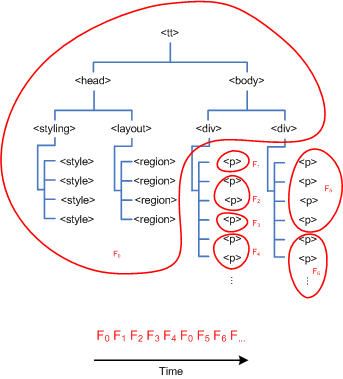Styling attributes are included in TTML to enable authorial intent of presentation
to be included within a self-contained document. This section describes
the semantics of style presentation in terms of a standard processing
model. TTML Processors are not required to present document instances in any particular way;
but an implementation of this model by a TTML presentation processor
that provides externally observable results that are consistent with this model is
likely to lead to a user experience that closely resembles the experience intended by
the documents' authors.
The semantics of TTML style presentation are described in terms of the model
in [XSL 1.1]. The effects of the attributes in this section
are intended to be compatible with the layout and formatting model of XSL; however, Presentation agents
may use any technology to satisfy the authorial intent of the document. In particular
since [CSS2] is a subset of this model, a CSS processor may be used
for the features that the models have in common.
10.2 Styling Attribute Vocabulary
This section defines the 10.2.1 style attribute used
with certain animation elements, content elements, certain layout elements, and style definition elements.
In addition, this section specifies the following attributes in the TT Style Namespace
for use with style definition elements, certain layout elements, and content elements
that support inline style specifications:
Unless explicitly permitted by an element type definition, an attribute in the TT Style Namespace should not be specified on an element
unless it either applies to that element or denotes an inheritable style property. If it does not apply to that element
and does not denote an inheritable style property, then it must be ignored for the purpose of non-validation processing.
In the case of validation processing, such usage should be reported as a warning, or, if strict validation is performed,
as an error.
Unless explicitly stated otherwise, linear white-space (LWSP) must
appear between adjacent non-terminal components of a value of a TT
Style property value unless some other delimiter is permitted and used.
Note:
This specification makes use of lowerCamelCased local
names for style attributes that
are based upon like-named properties defined by [XSL 1.1].
This convention is likewise extended to token values of such
properties.
Note:
An inheritable style property may be expressed as a specified attribute on the
root tt element or on a
content element type
independently of whether the property applies to that
element type. This capability permits the expression of an inheritable
style property on ancestor elements to which the property
does not apply.
Note:
Due to the general syntax of this specification (and the schemas it references) with respect
to how style attributes are specified, particularly for the purpose of supporting inheritance,
it is possible for an author to inadvertently specify a non-inheritable style attribute on
an element that applies neither to that element or any of its descendants while still remaining
conformant from a content validity perspective. Content authors may wish to make use of TTML
content verification tools that detect and warn about such usage.
10.2.1 style
The style attribute is used by referential style association
to reference one or more style elements each of which define a style (property) set.
The style attribute may be specified by an instance of the following
element types:
If specified, the value of a style attribute must
adhere to the IDREFS data type defined by [XML Schema Part 2],
§ 3.3.10, and, furthermore, each IDREF must reference a style element
which has a styling element as an ancestor.
If the same IDREF, ID1, appears more than one time in the value of a style
attribute, then there should be an intervening IDREF, ID2, where
ID2 is not equal to ID1.
Note:
This constraint is intended to discourage the use of redundant referential styling while still
allowing the same style to be referenced multiple times in order to potentially override prior
referenced styles, e.g., when an intervening, distinct style is referenced in the IDREFS list.
10.2.2 tts:backgroundClip
The tts:backgroundClip attribute is used to specify a style property that
determines the background painting rectangle within
which the background is painted.
This attribute may be specified by any element type
that permits use of attributes in the TT Style Namespace; however, this attribute applies
as a style property only to those element types indicated in the following table.
| Values: |
border |
content |
padding |
|
| Initial: | border |
| Applies to: |
body,
div,
p,
region,
span
|
| Inherited: | no |
| Percentages: | N/A |
| Animatable: | discrete |
For the purpose of determining applicability of this style property,
each character child of a p element is considered to be enclosed in an anonymous
span.
The tts:backgroundClip style is illustrated by the following example.
Example Fragment – Background Clip
<region xml:id="r1">
<style tts:extent="306px 114px"/>
<style tts:backgroundImage="#embeddedImage"/>
<style tts:backgroundClip="content"/>
</region>
|
| Editorial note: Background Clip Example Image | 2014-11-21 |
| Insert image of backgroundClip example. |
10.2.3 tts:backgroundColor
The tts:backgroundColor attribute is used to specify a style property that
defines the background color of a region or an area generated by content flowed into a region.
Issue (issue-ttml2-101):
Line Area Background Height
Source: https://github.com/w3c/ttml2/issues/101
Fix definition of block progression dimension of background area of a line area. Neither XSL-FO nor CSS are sufficiently precise.
Resolution:
None recorded.
This attribute may be specified by any
element type
that permits use of attributes in the TT Style Namespace; however, this attribute applies
as a style property only to those element types indicated in the following table.
| Values: |
<color>
|
| Initial: | transparent |
| Applies to: |
body,
div,
p,
region,
span
|
| Inherited: | no |
| Percentages: | N/A |
| Animatable: | discrete, continuous |
For the purpose of determining applicability of this style property,
each character child of a p element is considered to be enclosed in an anonymous
span.
The tts:backgroundColor style is illustrated by the following example.
Example Fragment – Background Color
<region xml:id="r1">
<style tts:extent="306px 114px"/>
<style tts:backgroundColor="red"/>
<style tts:color="white"/>
<style tts:displayAlign="after"/>
<style tts:padding="3px 40px"/>
</region>
...
<p region="r1" tts:backgroundColor="purple" tts:textAlign="center">
Twinkle, twinkle, little bat!<br/>
How <span tts:backgroundColor="green">I wonder</span> where you're at!
</p>
|
Example Rendition – Background Color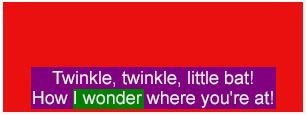 |
Note:
The semantics of the style property represented by this attribute are based upon
that defined by [XSL 1.1], § 7.8.2.
10.2.4 tts:backgroundExtent
The tts:backgroundExtent attribute may be used to specify the extent (size) of a background image
independently of the image's intrinsic extent (size).
This attribute may be specified by any element type
that permits use of attributes in the TT Style Namespace; however, this attribute applies
as a style property only to those element types indicated in the following table.
If the value of this attribute is auto, then the computed value
of the style property must be considered to be the same as the intrinsic extent (size) of the associated background image.
If the value of this attribute is contain, then the computed value
of the style property is determined by performing the
[compute containment scaling] procedure,
where the target rectangle TR is initialized to the intrinsic width and height of the image,
the reference rectangle RR is set to the background positioning rectangle,
and the resulting output value of the target rectangle TR is the computed value.
If the value of this attribute is cover, then the computed value
of the style property is determined by performing the
[compute cover scaling] procedure,
where the target rectangle TR is initialized to the intrinsic width and height of the image,
the reference rectangle RR is set to the background positioning rectangle,
and the resulting output value of the target rectangle TR is the computed value.
If the value of this attribute consists of two <measure>
specifications, then the first specification is the width and the second specification is the height,
respectively, of the computed value of this property, in which case both <measure> specifications
must resolve (or be resolvable) to non-negative lengths.
If the computed value of this style property differs from the image's intrinsic extent (size), then the image raster is scaled independently
in each dimension to match the computed extent value.
If a computed value of the property associated with this attribute is not supported,
then a presentation processor must use the closest supported value.
Note:
In this context, the phrase closest supported value means the value for which the Euclidean distance between
the computed background extent and the supported background extent is minimized. If there are multiple closest supported values equally distant from
the computed value, then the value most distant from [0,0], i.e., of greatest extent, is used.
This rule for resolving closest supported value makes use of the nearest larger rather than nearest smaller supported distance.
The tts:backgroundExtent style is illustrated by the following example.
Example Fragment – Background Extent
<region xml:id="r1">
<style tts:extent="306px 114px"/>
<style tts:backgroundImage="#embeddedImage"/>
<style tts:backgroundExtent="cover"/>
</region>
|
| Editorial note: Background Extent Example Image | 2016-09-09 |
| Insert image of backgroundExtent example. |
10.2.5 tts:backgroundImage
The tts:backgroundImage attribute is used to specify a style property that
designates a background non-content image to be rendered as
the background image of a region or an area generated by content flowed into a region.
A tts:backgroundImage attribute should not make reference to a content image
used to represent actual content, such as a raster image rendering of a caption. Rather, the use of tts:backgroundImage
should be limited to styling the background of an element where the content is represented by other means. If it is necessary
to represent content using a raster image, then it should be expressed by means of an image
element in a block or inline context.
This attribute may be specified by any
element type
that permits use of attributes in the TT Style Namespace; however, this attribute applies
as a style property only to those element types indicated in the following table.
| Editorial note: Intrinsic Image Size and Content Rectangle Size | 2016-04-16 |
| Does background image intrinsic size affect min-{height,width} of content area to which it is applied? SMPTE-TT mandates that
min-{height,width} are based on background image intrinsic size; however, this is at variance with XSL-FO and CSS, where background image size
has no affect on the size of the content rectangle. IMSC1 does not explicitly address this issue, but appears to assume that the SMPTE-TT
semantics apply. |
For the purpose of determining applicability of this style property,
each character child of a p element is considered to be enclosed in an anonymous
span.
An <image> expression used with this style property may directly reference an external image resource;
however, authors should refrain from doing so, and instead, constrain their usage to only refer to image
children of a resources element.
Note:
Referring indirectly to an image by means of an image element makes it possible to
specify an image as an embedded data resource, and specify
additional information about the image, such as its content type, etc. Furthermore, by exploiting the use of multiple
source children in an image element,
it becomes possible to specify resolution specific images and fallback image resources.
The tts:backgroundImage style is illustrated by the following example.
Example Fragment – Background Image using Embedded Image Resource
<head>
<resources>
<image xml:id="embeddedImage">
<source>
<data type="image/png" length="119">
iVBORw0KGgoAAAANSUhEUgAAAAEAAAABCAIAAACQd1PeAAAAAXNSR0IArs4c6QAAAARnQU1BAACxjwv8
YQUAAAAJcEhZcwAADsMAAA7DAcdvqGQAAAAMSURBVBhXY2BgYAAAAAQAAVzN/2kAAAAASUVORK5CYII=
</data>
</source>
</image>
</resources>
</head>
...
<region xml:id="r1">
<style tts:extent="306px 114px"/>
<style tts:backgroundImage="red"/>
<style tts:backgroundImage="#embeddedImage"/>
<style tts:color="white"/>
<style tts:displayAlign="after"/>
<style tts:padding="3px 40px"/>
</region>
|
| Editorial note: Background Image Example Image | 2014-11-21 |
| Insert image of backgroundImage example. |
Note:
The semantics of the style property represented by this attribute are based upon
that defined by [XSL 1.1], § 7.8.3.
10.2.6 tts:backgroundOrigin
The tts:backgroundOrigin attribute is used to specify a style property that
determines the background positioning rectangle within
which the background is positioned.
This attribute may be specified by any element type
that permits use of attributes in the TT Style Namespace; however, this attribute applies
as a style property only to those element types indicated in the following table.
| Values: |
border |
content |
padding |
|
| Initial: | padding |
| Applies to: |
body,
div,
p,
region,
span
|
| Inherited: | no |
| Percentages: | N/A |
| Animatable: | discrete |
For the purpose of determining applicability of this style property,
each character child of a p element is considered to be enclosed in an anonymous
span.
The tts:backgroundOrigin style is illustrated by the following example.
Example Fragment – Background Origin
<region xml:id="r1">
<style tts:extent="306px 114px"/>
<style tts:backgroundImage="#embeddedImage"/>
<style tts:backgroundOrigin="content"/>
</region>
|
| Editorial note: Background Origin Example Image | 2014-11-21 |
| Insert image of backgroundOrigin example. |
10.2.7 tts:backgroundPosition
The tts:backgroundPosition attribute is used to specify a style property that
defines whether and how a background image is positioned in a region or an area generated by content flowed into a region.
This attribute may be specified by any element type
that permits use of attributes in the TT Style Namespace; however, this attribute applies
as a style property only to those element types indicated in the following table.
For the purpose of determining applicability of this style property,
each character child of a p element is considered to be enclosed in an anonymous
span.
A percentage value component for a horizontal position offset is relative to the width of the
background positioning rectangle minus the width of the background image.
A percentage value component for a vertical position offset is relative to the height of the
background positioning rectangle minus the height of the background image.
The tts:backgroundPosition style is illustrated by the following example.
Example Fragment – Background Position
<region xml:id="r1">
<style tts:extent="306px 114px"/>
<style tts:backgroundImage="#embeddedImage"/>
<style tts:backgroundPosition="center"/>
</region>
|
| Editorial note: Background Position Example Image | 2014-11-21 |
| Insert image of backgroundPosition example. |
Note:
The semantics of the style property represented by this attribute are based upon
that defined by [CSS2], § 14.2.
10.2.8 tts:backgroundRepeat
The tts:backgroundRepeat attribute is used to specify a style property that
defines whether and how a background image is repeated (tiled) into a region or an area generated by content flowed into a region.
This attribute may be specified by any element type
that permits use of attributes in the TT Style Namespace; however, this attribute applies
as a style property only to those element types indicated in the following table.
| Values: |
repeat |
repeatX |
repeatY |
noRepeat
|
| Initial: | repeat |
| Applies to: |
body,
div,
p,
region,
span
|
| Inherited: | no |
| Percentages: | N/A |
| Animatable: | discrete |
For the purpose of determining applicability of this style property,
each character child of a p element is considered to be enclosed in an anonymous
span.
The tts:backgroundRepeat style is illustrated by the following example.
Example Fragment – Background Repeat
<region xml:id="r1">
<style tts:extent="306px 114px"/>
<style tts:backgroundImage="#embeddedImage"/>
<style tts:backgroundRepeat="repeatX"/>
</region>
|
| Editorial note: Background Repeat Example Image | 2014-11-21 |
| Insert image of backgroundRepeat example. |
Note:
The semantics of the style property represented by this attribute are based upon
that defined by [XSL 1.1], § 7.8.4.
10.2.9 tts:border
The tts:border attribute is used to specify a style property that
defines the border of a region or an area generated by content flowed into a region.
This attribute may be specified by any
element type
that permits use of attributes in the TT Style Namespace; however, this attribute applies
as a style property only to those element types indicated in the following table.
For the purpose of determining applicability of this style property,
each character child of a p element is considered to be enclosed in an anonymous
span.
If no border thickness is specified in the value of the tts:border property,
then the border thickness must be interpreted as if a thickness of
medium were specified.
If a computed value of the border thickness associated with this attribute is not supported,
then a presentation processor must use the closest supported value.
Note:
In this context, the phrase closest supported value means the value for which the one-dimensional Euclidean distance between
the computed border thickness and the supported border thickness is minimized on a per-edge basis. If there are multiple closest supported values equally distant from
the computed value for a given edge, then the value least distant from 0, i.e., the least border thickness, is used.
If no border style is specified in the value of the tts:border property,
then the border style must be interpreted as if a style of
none were specified.
If a computed value of the border style associated with this attribute is not supported,
then a presentation processor must use the value solid.
If no border color is specified in the value of the tts:border property,
then the border color must be interpreted as if a color equal
to the computed value of the element's tts:color style property were specified.
If no border radii is specified in the value of the tts:border property,
then the border radii must be interpreted as if a radii of
0 were specified.
If a computed value of the border radii associated with this attribute is not supported,
then a presentation processor must use the closest supported value.
Note:
In this context, the phrase closest supported value means the value for which the computed border radii and the supported border radii
is minimized.
The tts:border style is illustrated by the following example.
Example Fragment – Border
<region xml:id="r1">
<style tts:extent="306px 114px"/>
<style tts:border="2px solid red"/>
<style tts:color="white"/>
<style tts:displayAlign="after"/>
<style tts:padding="3px 40px"/>
</region>
...
<p region="r1" tts:border="4px solid green" tts:textAlign="center">
Twinkle, twinkle, little bat!<br/>
How <span tts:border="8px solid blue">I wonder</span> where you're at!
</p>
|
| Editorial note: Border Example Image | 2013-08-24 |
| Insert image of border example. |
10.2.10 tts:bpd
The tts:bpd attribute is used to specify the
block progression dimension, or, more succinctly, the bpd of an area generated by content flowed into a region.
Note:
The term block progression dimension is interpreted in a writing mode relative manner
such that bpd always corresponds to a measure in the block
progression direction. Therefore, in horizontal writing modes, bpd expresses a vertical measure,
while, in vertical writing mode, bpd expresses a horizontal measure,
where horizontal and vertical are always interpreted in an absolute sense.
If a tts:bpd attribute is specified on a span element,
then that span element must be processed using
inline block display semantics for the purpose of presentation processing.
This attribute may be specified by any
element type
that permits use of attributes in the TT Style Namespace; however, this attribute applies
as a style property only to those element types indicated in the following table.
| Values: |
<measure>
|
| Initial: | auto |
| Applies to: |
div,
p,
span
|
| Inherited: | no |
| Percentages: | see prose |
| Animatable: | discrete, continuous |
If a <measure> is expressed as a <length> value, then it must be non-negative.
The tts:bpd style is illustrated by the following example.
| Editorial note: Block Progression Dimension Percentage | 2014-11-29 |
| Specify resolution of percentage value. |
| Editorial note: Block Progression Dimension Example | 2014-11-29 |
| Insert example fragment and image of tts:bpd. |
Note:
The semantics of the style property
represented by this attribute are based upon the height property defined by [XSL 1.1],
§ 7.15.6 and [CSS Box Model], § 9
10.2.11 tts:color
The tts:color attribute is used to specify a style property that
defines the foreground color of marks associated with an area generated by content flowed into a region.
This attribute may be specified by any
element type
that permits use of attributes in the TT Style Namespace; however, this attribute applies
as a style property only to those element types indicated in the following table.
| Values: |
<color>
|
| Initial: | see prose |
| Applies to: |
span
|
| Inherited: | yes |
| Percentages: | N/A |
| Animatable: | discrete, continuous |
For the purpose of determining applicability of this style property,
each character child of a p element is considered to be enclosed in an anonymous
span.
The initial value of the tts:color property
is considered to be implementation dependent. In the absence of
end-user preference information, a conformant presentation processor
should use an initial value that is highly contrastive to the
background color of the root container region.
The tts:color style is illustrated by the following example.
Example Fragment – Color
<region xml:id="r1">
<style tts:backgroundColor="black"/>
<style tts:color="white"/>
<style tts:displayAlign="after"/>
<style tts:textAlign="center"/>
</region>
...
<p region="r1">
In spring, when woods are <span tts:color="green">getting green</span>,<br/>
I'll try and tell you what I mean.
</p>
|
Example Rendition – Color |
Note:
The semantics of the style property
represented by this attribute are based upon that defined by [XSL 1.1],
§ 7.18.1.
10.2.12 tts:direction
The tts:direction attribute is used to specify a style property that
defines the directionality of an embedding or override according to
the Unicode bidirectional algorithm.
This attribute may be specified by any
element type
that permits use of attributes in the TT Style Namespace; however, this attribute applies
as a style property only to those element types indicated in the following table.
| Values: |
ltr |
rtl
|
| Initial: |
ltr
|
| Applies to: |
p,
span
|
| Inherited: | yes |
| Percentages: | N/A |
| Animatable: | discrete |
For the purpose of determining applicability of this style property,
each character child of a p element is considered to be enclosed in an anonymous
span.
When applied to a p element, the computed value of this property explicitly establishes the
paragraph embedding level as specified by [UAX9], § 4.3, Rule HL1.
If a computed value of the property associated with this attribute is not supported,
then a presentation processor must use the value ltr.
The tts:direction style is illustrated by the following example.
Example Fragment – Direction
<region xml:id="r1">
<style tts:extent="265px 84px"/>
<style tts:padding="5px"/>
<style tts:backgroundColor="black"/>
<style tts:color="white"/>
<style tts:displayAlign="after"/>
<style tts:textAlign="center"/>
</region>
...
<p region="r1">
Little birds are playing<br/>
Bagpipes on the shore,<br/>
<span tts:unicodeBidi="bidiOverride" tts:direction="rtl">where the tourists snore.</span>
</p>
|
Example Rendition – Direction

|
Note:
The semantics of the style property
represented by this attribute are based upon that defined by [XSL 1.1],
§ 7.29.1.
10.2.13 tts:disparity
The tts:disparity attribute is used to specify the binocular disparity to be applied
in order to simulate stereopsis (stereoscopic depth). A disparity of zero corresponds to the plane of display; a negative value corresponds to depths in front
of the plane of display; and a positive value corresponds to depths behind the plane of display. See [SMITH] for details on the relationship
between disparity and perceived depth.
This attribute may be specified by any element type
that permits use of attributes in the TT Style Namespace; however, this attribute applies
as a style property only to those element types indicated in the following table.
When rendering a region on the right (left) image of a stereoscopic image pair, the center of the region is offset along the horizontal axis by a value equal to ½ (-½) the computed value of tts:disparity, where a positive offset is to the right, and a negative offset is to the left.
Unless rendering onto a steroscopic image pair, the tts:disparity attribute is ignored for the purpose of presentation processing.
The author should ensure that the perceived depth of a region is positioned in front of any object in the scene during the entire time the region is visible. The stereoscopic effect will be broken if an object in the scene is perceived to be in front of the region.
If a tts:disparity attribute is specified on a div or p element, then that specification must be considered to be
equivalent to specifying an anonymous inline region child of the div or p element, where the
disparity of the corresponding region, also referred to as an implied inline region, is equal to the
value of this attribute.
If applicable, inheritance of disparity occurs only by means of 10.4.2.3 Root Style Inheritance, whether the inheriting region is
an out-of-line region,
an inline region,
or an implied inline region.
If a computed value of the property associated with this attribute is not supported,
then a presentation processor must use the closest supported value.
Note:
In this context, the phrase closest supported value means the value for which the Euclidean distance between
the computed disparity and the supported disparity is minimized. If there are multiple closest supported values equally distant from
the computed value, then the value least distant from 0 is used.
Note:
In general, the presentation of stereoscopic content depends on the use
of sub-pixel (anti-aliasing) rendering techniques; as such, implementations
that quantize disparity adjusted positions to an an integral value
may produce undesirable side effects. This is particularly
disconcerting when smooth animation of disparity applies, e.g.,
when the author is attempting to maintain a constant distance between a subject and
its associated text.
The tts:disparity style is illustrated by the following example fragment and rendition. Note that, in typical television scenarios, disparity ranges from -1% to 2% of screen width. This example, which uses a disparity of 5%, exaggerates the effects of disparity for clarity of illustration.
Example Fragment – Disparity
<region xml:id="r1">
<style tts:extent="80% 10%"/>
<style tts:origin="10% 10%"/>
<style tts:disparity="5%"/>
...
</region>
...
<p region="r1">
Stereoscopic
</p>
|
Example Rendition – Disparity (Left and Right Images)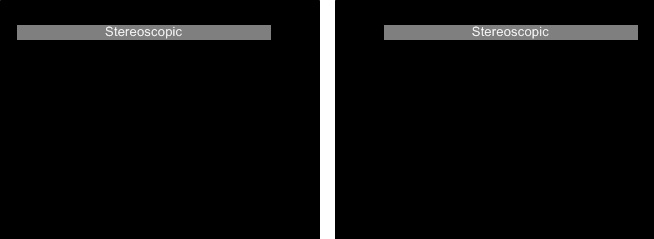 |
10.2.14 tts:display
The tts:display attribute is used to specify a style property that
defines whether an element is a candidate for layout and composition
in a region.
This attribute may be specified by any
element type
that permits use of attributes in the TT Style Namespace; however, this attribute applies
as a style property only to those element types indicated in the following table.
| Values: |
auto |
none
|
| Initial: |
auto
|
| Applies to: |
body,
div,
p,
region,
span
|
| Inherited: | no |
| Percentages: | N/A |
| Animatable: | discrete |
For the purpose of determining applicability of this style property,
each character child of a p element is considered to be enclosed in an anonymous
span.
If the value of this attribute is auto,
then the affected element is a candidate for region layout and
presentation; however, if the value is none, then the
affected element and its descendants must be considered ineligible for region
layout and presentation.
The tts:display style is illustrated by the following example.
Example Fragment – Display
<region xml:id="r1">
<style tts:extent="369px 119px"
tts:backgroundColor="black"
tts:color="white"
tts:displayAlign="before"
tts:textAlign="start"/>
</region>
...
<div region="r1">
<p dur="5s">
[[[
<span tts:display="none">
<set begin="1s" dur="1s" tts:display="auto"/>
Beautiful soup,
</span>
<span tts:display="none">
<set begin="2s" dur="1s" tts:display="auto"/>
so rich and green,
</span>
<span tts:display="none">
<set begin="3s" dur="1s" tts:display="auto"/>
waiting in a hot tureen!
</span>
]]]
</p>
</div>
|
Example Rendition – Display

|

|

|

|

|
Note:
The semantics of the style property
represented by this attribute are based upon that defined by [CSS2], § 9.2.4.
10.2.15 tts:displayAlign
The tts:displayAlign attribute is used to specify a style property that
defines the alignment of block areas in the block progression direction.
| Editorial note: Justification in Block Progression Dimension | 2015-01-14 |
Add justify value to support justification in block progression dimension. |
This attribute may be specified by any
element type
that permits use of attributes in the TT Style Namespace; however, this attribute applies
as a style property only to those element types indicated in the following table.
| Values: |
before |
center |
after
|
| Initial: |
before
|
| Applies to: |
region
|
| Inherited: | no |
| Percentages: | N/A |
| Animatable: | discrete |
If a computed value of the property associated with this attribute is not supported,
then a presentation processor must use the value before.
The tts:displayAlign style is illustrated by the following example.
Example Fragment – Display Align
<region xml:id="r1">
<style tts:extent="128px 66px" tts:origin="0px 0px"
tts:backgroundColor="black" tts:color="white"/>
<style tts:displayAlign="before"/>
<style tts:textAlign="start"/>
</region>
<region xml:id="r2">
<style tts:extent="192px 66px" tts:origin="128px 66px"/>
tts:backgroundColor="green" tts:color="white"/>
<style tts:displayAlign="after"/>
<style tts:textAlign="start"/>
</region>
<region xml:id="r3">
<style tts:extent="128px 66px"/> style tts:origin="0px 132px"
tts:backgroundColor="black" tts:color="white"/>
<style tts:displayAlign="before"/>
<style tts:textAlign="start"/>
</region>
<region xml:id="r4">
<style tts:extent="192px 66px" tts:origin="128px 198px"/>
tts:backgroundColor="green" tts:color="white"/>
<style tts:displayAlign="after"/>
<style tts:textAlign="start"/>
</region>
...
<div>
<p region="r1">I sent a message to the fish:</p>
<p region="r2">I told them<br/> "This is what I wish."</p>
<p region="r3">The little fishes of the sea,</p>
<p region="r4">They sent an<br/> answer back to me.</p>
</div>
|
Example Rendition – Display Align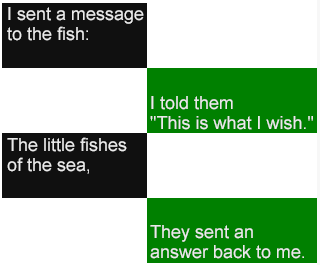 |
Note:
The semantics of the style property
represented by this attribute are based upon that defined by [XSL 1.1],
§ 7.14.4.
10.2.16 tts:extent
The tts:extent attribute may be used for the following purposes:
to specify the width and height
of the root container region,
which has the effect of defining
the document coordinate space,
about which see also H Root Container Region Semantics;
to specify or override the
width and height
of a content region;
to specify the
width and height
of an image, overriding its intrinsic extent.
This attribute may be specified by any
element type
that permits use of attributes in the TT Style Namespace; however, this attribute applies
as a style property only to those element types indicated in the following table.
If a tts:extent attribute is specified on the tt element,
then the specified value is restricted to one of the following:
(1) the auto keyword,
(2) the contain keyword, or
(3) two <length> specifications,
where these specifications are expressed as non-percentage, definite lengths using pixel units.
All other syntactically legal values must not be used in this context, and,
if used, must be considered an error for the purpose of validation processing and must be ignored
for the purpose of presentation processing, in which case the initial value (auto) applies.
If a tts:extent attribute is specified on a region element,
then its computed value determines the width and height
of the associated content region.
If a tts:extent attribute is specified on an image element, then its computed value determines the width and height of the image.
If a tts:extent attribute is specified on a div or p element, then the semantics specified by
10.2.16.1 Special Usage apply.
If the value of this attribute is auto, then the computed value of its associated property is determined as follows:
if the property applies to the tt element, then auto is interpreted as if the value contain
were specified;
if the property applies to a region element, either directly or indirectly, then auto is interpreted as if
the value "auto auto" were specified;
if the property applies to an image element, then auto
is interpreted as if a value equal to the image's intrinsic extent were specified using two pixel-based <length> components, for example, "200px 100px".
If the value of this attribute is contain, then the computed value of its associated property is determined as follows:
if the property applies to the tt element, then contain is interpreted as specified in
H Root Container Region Semantics;
if the property applies to a region element,
then the computed value is determined by performing the
[compute containment scaling] procedure,
where the target rectangle TR is initialized to the
intrinsic block content extent of the region's content,
the reference rectangle RR is set to the extent of the root container region,
and the resulting output value of the target rectangle TR is the computed value;
if the property applies to an image element,
then the computed value is determined by performing the
[compute containment scaling] procedure,
where the target rectangle TR is initialized to the
intrinsic image extent of the image,
the reference rectangle RR is set to the available content space in the containing block area or line area
in accordance to whether the current formatting context is a block or inline formatting context, respectively,
and the resulting output value of the target rectangle TR is the computed value.
If the value of this attribute is cover, then the computed value of its associated property is determined as follows:
if the property applies to a region element,
then the computed value is determined by performing the
[compute cover scaling] procedure,
where the target rectangle TR is initialized to the
intrinsic block content extent of the region's content,
the reference rectangle RR is set to the extent of the root container region,
and the resulting output value of the target rectangle TR is the computed value;
if the property applies to an image element,
then the computed value is determined by performing the
[compute cover scaling] procedure,
where the target rectangle TR is initialized to the
intrinsic image extent of the image,
the reference rectangle RR is set to the available content space in the containing block area or line area
in accordance to whether the current formatting context is a block or inline formatting context, respectively,
and the resulting output value of the target rectangle TR is the computed value.
If the value of this attribute consists of two <measure>
specifications, then they must be interpreted as
width and height, where the first specification is the
width, and the second specification is the height,
in which case both <measure>
specifications must resolve (or be resolvable) to non-negative lengths.
If a computed value of the property associated with this attribute is not supported,
then a presentation processor must use the closest supported value.
Note:
In this context, the phrase closest supported value means the value for which the Euclidean distance between
the computed extent and the supported extent is minimized. If there are multiple closest supported values equally distant from
the computed value, then the value most distant from [0,0], i.e., of greatest extent, is used.
This rule for resolving closest supported value makes use of the nearest larger rather than nearest smaller supported distance.
The rationale for this difference in treatment is
that use of a larger extent ensures that the affected content will be contained in the region area without causing region overflow,
while use of a smaller extent makes region overflow more likely.
The tts:extent style is illustrated by the following example.
Example Fragment – Extent
<region xml:id="r1">
<style tts:extent="330px 122px"/>
<style tts:backgroundColor="black"/>
<style tts:color="white"/>
<style tts:displayAlign="after"/>
<style tts:textAlign="center"/>
</region>
...
<p region="r1">
'Tis the voice of the Lobster:<br/>
I heard him declare,<br/>
"You have baked me too brown,<br/>
I must sugar my hair."
</p>
|
Example Rendition – Extent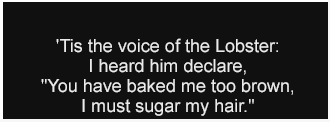 |
10.2.16.1 Special Usage
| Editorial note: Revision Required - Issue #168 | 2016-11-05 |
| Revise or rewrite the following paragraph as required for issue #168. |
If a tts:extent attribute is specified on a div or p element, then that specification must be considered to be
equivalent to specifying an anonymous inline region child of the div or p element, where the
extent of the corresponding region, also referred to as an implied inline region, is equal to the
value of this attribute.
10.2.17 tts:fontFamily
The tts:fontFamily attribute is used to specify a style property that
defines the font family from which glyphs are selected for glyph areas generated
by content flowed into a region.
This attribute may be specified by any
element type
that permits use of attributes in the TT Style Namespace; however, this attribute applies
as a style property only to those element types indicated in the following table.
For the purpose of determining applicability of this style property,
each character child of a p element is considered to be enclosed in an anonymous
span.
If a computed value of the property associated with this attribute is not supported, then a
presentation processor must attempt to map the computed font family
to a supported font family that has similar typographic
characteristics, or, in the absence of such a mapping, it must
use the value default.
The tts:fontFamily style is illustrated by the following example.
Example Fragment – Font Family
<region xml:id="r1">
<style tts:extent="474px 146px"/>
<style tts:backgroundColor="black"/>
<style tts:color="white"/>
<style tts:displayAlign="center"/>
<style tts:textAlign="start"/>
<style tts:fontFamily="proportionalSansSerif"/>
</region>
...
<div region="r1">
<p>
"The time has come," the Walrus said,<br/>
"to talk of many things:
</p>
<p tts:textAlign="end" tts:fontFamily="monospaceSerif">
Of shoes, and ships, and sealing wax,<br/>
Of cabbages and kings,
</p>
<p>
And why the sea is boiling hot,<br/>
and whether pigs have wings."
</p>
</div>
|
Example Rendition – Font Family |
Note:
The semantics of the style property
represented by this attribute are based upon that defined by [XSL 1.1],
§ 7.9.2.
10.2.18 tts:fontKerning
The tts:fontKerning attribute is used to specify a style property that
determines whether font kerning is applied when positioning glyph areas.
This attribute may be specified by any element type
that permits use of attributes in the TT Style Namespace; however, this attribute applies
as a style property only to those element types indicated in the following table.
| Values: |
none |
normal
|
| Initial: | normal |
| Applies to: |
p
span
|
| Inherited: | yes |
| Percentages: | N/A |
| Animatable: | discrete |
For the purpose of determining applicability of this style property,
each character child of a p element is considered to be enclosed in an anonymous
span.
If the value of this attribute is normal, then kerning should be applied if kerning data is available.
If the value of this attribute is none, then kerning should not be applied whether or not kerning data is available.
If a computed value of the property associated with this attribute is not supported,
then a presentation processor must use the value normal.
The tts:fontKerning style is illustrated by the following
example.
| Editorial note: Font Kerning Example | 2015-01-05 |
| Insert example fragment and image of tts:fontKerning. |
Note:
The semantics of the style property
represented by this attribute are based upon that defined by [CSS Fonts],
§ 6.3.
10.2.19 tts:fontSelectionStrategy
| Editorial note: Font Selection | 2014-11-21 |
| Specify font selection semantics, including how multiple author defined font resources combine
with (local) platform defined font resources to obtain an ordered list of font resources for performing
character to glyph mapping. |
10.2.20 tts:fontShear
The tts:fontShear attribute is used to specify a style property that
determines whether and how a shear transformation is applied to glyph areas.
This attribute may be specified by any element type
that permits use of attributes in the TT Style Namespace; however, this attribute applies
as a style property only to those element types indicated in the following table.
| Values: |
<percentage>
|
| Initial: | 0% |
| Applies to: |
p
span
|
| Inherited: | yes |
| Percentages: | see prose |
| Animatable: | discrete, continuous |
If the value of this attribute is 0%, then no shear transformation is applied; if the value is 100%, then a 2D shear transformation
of 90 degrees is applied in the axis associated with the inline progression direction; if the value is -100%, then a shear transformation
of -90 degrees is applied. If the absolute value of the specified percentage is greater than 100%, then it must be interpreted as if 100% were specified with
the appropriate sign.
If the inline progression direction corresponds to the X axis, then the 2D shear transformation is described by the following matrix:
| 1 a 0 |
| 0 1 0 |
| 0 0 1 |
where a is equal to the tangent of the shear angle.
If the inline progression direction corresponds to the Y axis, then the 2D shear transformation is described by the following matrix:
| 1 0 0 |
| a 1 0 |
| 0 0 1 |
For the purpose of determining applicability of this style property,
each character child of a p element is considered to be enclosed in an anonymous
span.
The tts:fontShear style is illustrated by the following example.
Example Fragment – Font Shear
<p region="horizontal">
<span tts:fontShear="16.78842%">三日坊主</span><br/>
<span tts:fontShear="50%">三日坊主</span><br/>
<span tts:fontShear="64.333%">三日坊主</span>
</p>
<p region="vertical">
<span tts:fontShear="16.78842%">三日坊主</span><br/>
<span tts:fontShear="50%">三日坊主</span><br/>
<span tts:fontShear="64.333%">三日坊主</span>
</p>
|
Example Rendition – Font Shear |
Example Fragment – Font Shear w/negative values
<p region="horizontal">
<span tts:fontShear="-16.78842%">三日坊主</span><br/>
<span tts:fontShear="-50%">三日坊主</span><br/>
<span tts:fontShear="-64.333%">三日坊主</span>
</p>
<p region="vertical">
<span tts:fontShear="-16.78842%">三日坊主</span><br/>
<span tts:fontShear="-50%">三日坊主</span><br/>
<span tts:fontShear="-64.333%">三日坊主</span>
</p>
|
Example Rendition – Font Shear w/negative values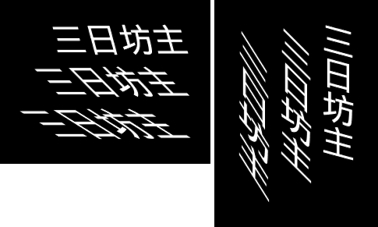 |
10.2.21 tts:fontSize
The tts:fontSize attribute is used to specify a style property
that defines the font size for glyphs that are selected for glyph areas
generated by content flowed into a region.
This attribute may be specified by any element type
that permits use of attributes in the TT Style Namespace; however, this attribute applies
as a style property only to those element types indicated in the following table.
| Values: |
<length> <length>?
|
| Initial: | 1c |
| Applies to: |
p,
span
|
| Inherited: | yes |
| Percentages: | if not region element,
then relative to parent element's font size; otherwise, relative to the
computed cell size |
| Animatable: | discrete, continuous |
Issue (issue-ttml2-133a):
Ruby Text Size Inheritance
Source: https://github.com/w3c/ttml2/issues/133
Special treatment is needed for inheritance of font size on ruby annotation text.
Resolution:
None recorded.
If a single <length> value is specified, then this length applies
equally to horizontal and vertical scaling of a glyph's EM square; if two
<length> values are specified, then the first expresses the horizontal
scaling and the second expresses vertical scaling.
Note:
Use of independent horizontal and vertical font sizes is expected to be used
with cell based units in order to denote fonts that are two rows in height and
one column in width.
Note:
A glyph's EM square is conventionally defined as the EM square of the font that contains the glyph. That is,
glyphs do not have an EM square that is distinct from their font's EM square.
If horizontal and vertical sizes are expressed independently, then the
units of the <length> values must be the same.
The <length> value(s) used to express font size must be non-negative.
For the purpose of determining applicability of this style property,
each character child of a p element is considered to be enclosed in an anonymous
span.
If a computed value of the property associated with this attribute is not supported,
then a presentation processor must use the closest supported value.
Note:
In this context, the phrase closest supported value means the value for which the Euclidean distance between
the computed font size and the supported font size is minimized. If there are multiple closest supported values equally distant from
the computed value, then the value most distant from 0 (single length specification) or [0,0] (two length specifications) is used,
i.e., the largest font size, is used.
Note:
The expression 1c means one cell, where 'c' expresses
the cell length unit as defined by 10.3.17 <length>.
When a single <length> is expressed using cell units, then it refers to the height of
the computed cell size.
When two <length> values are expressed using cell units, then the first refers to the width of
the computed cell size, and the second refers to the height of the
computed cell size.
The tts:fontSize style is illustrated by the following example.
Example Fragment – Font Size
<region xml:id="r1">
<style tts:extent="299px 97px"/>
<style tts:backgroundColor="black"/>
<style tts:color="white"/>
<style tts:displayAlign="center"/>
<style tts:textAlign="center"/>
<style tts:fontFamily="proportionalSansSerif"/>
<style tts:fontSize="18px"/>
</region>
...
<p region="r1">
Then fill up the glasses<br/>
with treacle and ink,<br/>
Or anything else<br/>
that is <span tts:fontSize="24px">pleasant</span> to drink.
</p>
|
Example Rendition – Font Size |
Note:
The semantics of the style property
represented by this attribute are based upon that defined by [XSL 1.1],
§ 7.9.4. The addition of a second length component to permit specifying font
width and height independently is an extension introduced by TTML.
10.2.22 tts:fontStyle
The tts:fontStyle attribute is used to specify a style property that
defines the font style to apply to glyphs that are selected for glyph areas generated
by content flowed into a region, where the mapping from font
style value to specific font face or style parameterization is not determined
by this specification.
This attribute may be specified by any
element type
that permits use of attributes in the TT Style Namespace; however, this attribute applies
as a style property only to those element types indicated in the following table.
| Values: |
normal |
italic |
oblique
|
| Initial: | normal |
| Applies to: |
p,
span
|
| Inherited: | yes |
| Percentages: | N/A |
| Animatable: | discrete |
For the purpose of determining applicability of this style property,
each character child of a p element is considered to be enclosed in an anonymous
span.
Use of the value oblique
denotes a shear transformation (at an unspecified
angle) in the inline progression dimension.
If a computed value of the property associated with this attribute is not supported,
then a presentation processor must use the value normal.
The tts:fontStyle style is illustrated by the following example.
Example Fragment – Font Style
<region xml:id="r1">
<style tts:extent="331px 84px"/>
<style tts:backgroundColor="black"/>
<style tts:color="white"/>
<style tts:displayAlign="after"/>
<style tts:textAlign="center"/>
<style tts:fontFamily="proportionalSansSerif"/>
</region>
...
<p region="r1">
In autumn, when the leaves are brown,<br/>
Take pen and ink, and <span tts:fontStyle="italic">write it down.</span>
</p>
|
Example Rendition – Font Style |
Note:
The semantics of the style property
represented by this attribute are based upon that defined by [XSL 1.1],
§ 7.9.7.
10.2.23 tts:fontVariant
The tts:fontVariant attribute is used to enable the selection
of typographic glyph variants.
This attribute may be specified by any
element type
that permits use of attributes in the TT Style Namespace; however, this attribute applies
as a style property only to those element types indicated in the following table.
| Values: |
<glyph-variant>
|
| Initial: | normal |
| Applies to: |
p,
span
|
| Inherited: | yes |
| Percentages: | N/A |
| Animatable: | discrete |
For the purpose of determining applicability of this style property,
each character child of a p element is considered to be enclosed in an anonymous
span.
If a computed value of the property associated with this attribute is not supported,
then a presentation processor must use the value normal.
| Editorial note: Font Position Variant Example | 2014-09-24 |
| Add example source and rendering of tts:fontVariant. |
Note:
The semantics of the style property
represented by this attribute are based upon that defined by [CSS Fonts],
§ 6.11.
10.2.24 tts:fontWeight
The tts:fontWeight attribute is used to specify a style property
that defines the font weight to apply to glyphs that are selected for glyph
areas generated by content flowed into a region, where the mapping from font
weight value to specific font face or weight parameterization is not determined
by this specification.
This attribute may be specified by any
element type
that permits use of attributes in the TT Style Namespace; however, this attribute applies
as a style property only to those element types indicated in the following table.
| Values: |
normal |
bold
|
| Initial: | normal |
| Applies to: |
p,
span
|
| Inherited: | yes |
| Percentages: | N/A |
| Animatable: | discrete |
For the purpose of determining applicability of this style property,
each character child of a p element is considered to be enclosed in an anonymous
span.
If a computed value of the property associated with this attribute is not supported,
then a presentation processor must use the value normal.
The tts:fontWeight style is illustrated by the following example.
Example Fragment – Font Weight
<region xml:id="r1">
<style tts:extent="376px 95px"/>
<style tts:backgroundColor="black"/>
<style tts:color="white"/>
<style tts:displayAlign="center"/>
<style tts:textAlign="center"/>
<style tts:fontFamily="proportionalSansSerif"/>
</region>
...
<p region="r1">
They told me you had been to her,<br/>
<span tts:fontWeight="bold">and mentioned me to him:</span><br/>
She gave me a good character<br/>
<span tts:fontWeight="bold">but said I could not swim.</span>
</p>
|
Example Rendition – Font Weight |
Note:
The semantics of the style property
represented by this attribute are based upon that defined by [XSL 1.1],
§ 7.9.9.
10.2.25 tts:ipd
The tts:ipd attribute is used to specify the
inline progression dimension, or, more succinctly, the ipd of an area generated by content flowed into a region.
Note:
The term inline progression dimension is interpreted in a writing mode relative manner
such that ipd always corresponds to a measure in the inline
progression direction. Therefore, in horizontal writing modes, ipd expresses a horizontal measure,
while, in vertical writing mode, ipd expresses a vertical measure,
where horizontal and vertical are always interpreted in an absolute sense.
If a tts:ipd attribute is specified on a span element,
then that span element must be processed using
inline block display semantics for the purpose of presentation processing.
This attribute may be specified by any
element type
that permits use of attributes in the TT Style Namespace; however, this attribute applies
as a style property only to those element types indicated in the following table.
| Values: |
<measure>
|
| Initial: | auto |
| Applies to: |
div,
p,
span
|
| Inherited: | no |
| Percentages: | see prose |
| Animatable: | discrete, continuous |
If a <measure> is expressed as a <length> value, then it must be non-negative.
The tts:ipd style is illustrated by the following example.
| Editorial note: Inline Progression Dimension Percentage | 2014-11-29 |
| Specify resolution of percentage value. |
| Editorial note: Inline Progression Dimension Example | 2014-11-29 |
| Insert example fragment and image of tts:ipd. |
Note:
The semantics of the style property
represented by this attribute are based upon the width property defined by [XSL 1.1],
§ 7.15.14 and [CSS Box Model], § 9
10.2.26 tts:letterSpacing
The tts:letterSpacing attribute is used to specify a style property that
increases or decreases the nominal distance between glyph areas.
Letter spacing has no affect at the beginning or ending of a line area, and must not
be applied to zero-advance glyphs. Furthermore, letter spacing must not cause normally connected glyphs,
e.g., as used in cursive scripts or with cursive fonts, to become disconnected.
Letter spacing is applied independently from kerning and justification. Depending upon the font(s) in use,
the script(s) being presented, and the capabilities of a presentation processor, either or both kerning and
justification may be applied in addition to letter spacing.
This attribute may be specified by any
element type
that permits use of attributes in the TT Style Namespace; however, this attribute applies
as a style property only to those element types indicated in the following table.
| Values: |
normal |
<length>
|
| Initial: | normal |
| Applies to: |
span
|
| Inherited: | yes |
| Percentages: | N/A |
| Animatable: | discrete, continuous |
For the purpose of determining applicability of this style property,
each character child of a p element is considered to be enclosed in an anonymous
span.
The value normal corresponds to specifying a <length> value of zero (0),
i.e., neither expand nor compress adjacent glyph spacing.
If a <length> value is expressed as a positive scalar,
then the spaces between adjacent glyphs are expanded by an additional amount equal to that scalar value.
If expressed as a negative scalar,
then the spaces between adjacent glyphs are compressed by an additional amount equal to that scalar value, possibly resulting
in overlapping glyph areas, up to a maximum amount that results an effective advance of zero (0).
If a computed value of the letter spacing associated with this attribute is not supported,
then a presentation processor must use the closest supported value.
Note:
In this context, the phrase closest supported value means the value for which the one-dimensional Euclidean distance between
the computed letter spacing and the supported letter spacing is minimized. If there are multiple closest supported values equally distant from
the computed value for a given edge, then the value least distant from 0 is used.
The tts:letterSpacing style is illustrated by the following
example.
| Editorial note: Letter Spacing Example | 2014-11-30 |
| Insert example fragment and image of tts:letterSpacing. |
Note:
The semantics of the style property
represented by this attribute are based upon that defined by [CSS Text],
§ 8.2.
10.2.27 tts:lineHeight
The tts:lineHeight attribute is used to specify a style property that
defines the inter-baseline separation between line areas generated by content flowed into a region.
Note:
Exceptionally, the term height in the token lineHeight or the phrase line height refers to
the axis that corresponds with the block progression dimension of an associated line area, which is the vertical axis in
horizontal writing modes, but is the horizontal axis in vertical writing modes.
Issue (issue-ttml2-87):
Normal Line Height Multiplier
Source: https://github.com/w3c/ttml2/issues/87
Re-visit choice of 120% versus 125% for multiplier used in interpreting normal line height.
Resolution:
None recorded.
This attribute may be specified by any
element type
that permits use of attributes in the TT Style Namespace; however, this attribute applies
as a style property only to those element types indicated in the following table.
| Values: |
normal |
<length>
|
| Initial: | normal |
| Applies to: |
p
|
| Inherited: | yes |
| Percentages: | relative to this element's font size |
| Animatable: | discrete, continuous |
Issue (issue-ttml2-133b):
Ruby Text Size Inheritance
Source: https://github.com/w3c/ttml2/issues/133
Special treatment is needed for inheritance of line height on ruby annotation text.
Resolution:
None recorded.
If the value of this attribute is normal, then the
computed value of this style property is determined as follows:
Let P be the p element to which this style property applies.
Let FF be the computed value of the tts:fontFamily style property that applies to P.
Let FS be the computed value of the tts:fontSize style property that applies to P.
Let F0 be the first font obtained when sequentially mapping each font family in FF to a set of available fonts,
where this set of available fonts is constrained as needed to satisfy the computed values of the tts:fontStyle and tts:fontWeight
style properties that apply to P.
If F0 is associated with font metrics that specify altitude A, descent D, and line gap G,
then set LH to the sum of scaled(A), scaled(D), and scaled(G),
where scaled(X) denotes font metric X scaled according to font size FS.
Otherwise, set LH to 125% of FS.
Set the computed value of this style property to LH.
Note:
If a content author wishes to avoid the possibility of different interpretations of normal, for example, due to differences in
the set of available fonts, then it is recommended that a
<length> value expression be used to explicitly specify line height value.
If specified as a <length>, then the length must
be non-negative.
If a computed value of the property associated with this attribute is not supported,
then a presentation processor must use the closest supported value.
Note:
In this context, the phrase closest supported value means the value for which the Euclidean distance between
the computed line height and the supported line height is minimized. If there are multiple closest supported values equally distant from
the computed value, then the value most distant from 0, i.e., the largest line height, is used.
The tts:lineHeight style is illustrated by the following example.
Example Fragment – Line Height
<region xml:id="r1">
<style tts:extent="255px 190px"/>
<style tts:backgroundColor="black"/>
<style tts:color="white"/>
<style tts:displayAlign="center"/>
<style tts:textAlign="start"/>
<style tts:fontFamily="proportionalSansSerif"/>
<style tts:fontSize="16px"/>
<style tts:lineHeight="32px"/>
</region>
...
<p region="r1">
He thought he saw an elephant,<br/>
That practised on a fife:<br/>
He looked again, and found it was<br/>
A letter from his wife.<br/>
"At length I realise," he said,<br/>
"The bitterness of Life.
"</p>
|
Example Rendition – Line Height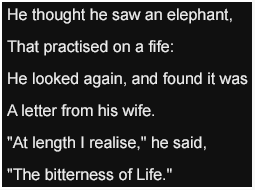 |
Note:
The semantics of the style property
represented by this attribute are based upon that defined by [XSL 1.1],
§ 7.16.4. Furthermore, it is the intention of this specification that the
allocation rectangle of a line be consistent with the per-inline-height-rectangle
as defined by [XSL 1.1], § 4.5, i.e., that a CSS-style line box stacking strategy be used.
10.2.28 tts:opacity
The tts:opacity attribute is used to specify a style property that
defines the opacity (or conversely, the transparency)
of marks associated with a region or an area generated by content flowed into a region.
When presented onto a visual medium, the opacity of the region is applied uniformly and on a linear scale
to all marks produced by content targeted to the
region after having applied applied any content element specific opacity to areas generated by that content.
This attribute may be specified by any
element type
that permits use of attributes in the TT Style Namespace; however, this attribute applies
as a style property only to those element types indicated in the following table.
| Values: |
<alpha>
|
| Initial: |
1.0
|
| Applies to: |
body,
div,
p,
region,
span
|
| Inherited: | no |
| Percentages: | N/A |
| Animatable: | discrete, continuous |
The tts:opacity style is illustrated by the following example.
| Editorial note: Enhance Opacity Example | 2013-08-26 |
| Enhance opacity example to demonstrate opacity on content elements. |
Example Fragment – Opacity
<region xml:id="r1" dur="5s">
<set begin="0s" dur="1s" tts:opacity="1.00"/>
<set begin="1s" dur="1s" tts:opacity="0.75"/>
<set begin="2s" dur="1s" tts:opacity="0.50"/>
<set begin="3s" dur="1s" tts:opacity="0.25"/>
<set begin="4s" dur="1s" tts:opacity="0.00"/>
<style tts:extent="304px 77px"/>
<style tts:backgroundColor="black"/>
<style tts:color="white"/>
<style tts:displayAlign="after"/>
<style tts:textAlign="center"/>
</region>
...
<p region="r1">
The sun was shining on the sea
</p>
|
Example Rendition – Opacity

|

|

|

|

|
Note:
The semantics of the style property
represented by this attribute are based upon that defined by [CSS3 Color],
§ 3.2.
10.2.29 tts:origin
The tts:origin attribute is used to specify the
x and y coordinates of the origin of a
region area with respect to the origin of the root container region.
If both tts:origin and tts:position attributes are
specified on an element and tts:position is a supported property,
then the tts:origin attribute must be ignored for the purpose of presentation processing.
This attribute may be specified by any element type
that permits use of attributes in the TT Style Namespace; however, this attribute applies
as a style property only to those element types indicated in the following table.
If the value of this attribute consists of two <length> specifications,
then they must be interpreted as x and y coordinates, where the first specification
is the x coordinate, and the second specification is the y coordinate.
If the value of this attribute is auto, then the computed value
of the style property must be considered to be the same as the origin of the root container region.
If a tts:origin attribute is specified on a div or p element, then that specification must be considered to be
equivalent to specifying an anonymous inline region child of the div or p element, where the
origin of the corresponding region, also referred to as an implied inline region, is equal to the
value of this attribute.
If a computed value of the property associated with this attribute is not supported,
then a presentation processor must use the closest supported value.
Note:
In this context, the phrase closest supported value means the value for which the Euclidean distance between
the computed origin and the supported origin is minimized. If there are multiple closest supported values equally distant from
the computed value, then the value least distant from [0,0], i.e., closest to the coordinate space origin, is used.
The tts:origin style is illustrated by the following example.
Example Fragment – Origin
<region xml:id="r1">
<style tts:origin="40px 40px"/>
<style tts:extent="308px 92px"/>
<style tts:backgroundColor="black"/>
<style tts:color="white"/>
<style tts:displayAlign="center"/>
<style tts:textAlign="center"/>
</region>
...
<p region="r1">
"To dine!" she shrieked in dragon-wrath.<br/>
"To swallow wines all foam and froth!<br/>
To simper at a table-cloth!"
</p>
|
Example Rendition – Origin |
10.2.30 tts:overflow
The tts:overflow attribute is used to specify a style property that
defines whether a region area is clipped or not if the descendant areas of the region overflow
its extent.
This attribute may be specified by any
element type
that permits use of attributes in the TT Style Namespace; however, this attribute applies
as a style property only to those element types indicated in the following table.
| Values: |
visible |
hidden
|
| Initial: | hidden |
| Applies to: |
region
|
| Inherited: | no |
| Percentages: | N/A |
| Animatable: | discrete |
If the value of this attribute is visible, then content should
not be clipped outside of the affected region.
If the value is hidden, then content should
be clipped outside of the affected region.
Note:
Unless a manual line break element br is used by the content author,
a paragraph of a given region will generate no more than one line area in that
region if the computed values of the tts:overflow and tts:wrapOption
style properties of the region are visible and noWrap,
respectively.
If a computed value of the property associated with this attribute is not supported,
then a presentation processor must use the value hidden.
The tts:overflow style is illustrated by the following example.
Example Fragment – Overflow
<region xml:id="r1">
<style tts:extent="232px 40px"/>
<style tts:origin="0px 0px"/>
<style tts:backgroundColor="black"/>
<style tts:color="red"/>
<style tts:displayAlign="before"/>
<style tts:textAlign="start"/>
<style tts:fontFamily="proportionalSansSerif"/>
<style tts:fontSize="18px"/>
<style tts:wrapOption="noWrap"/>
<style tts:overflow="visible"/>
</region>
<region xml:id="r2">
<style tts:extent="232px 40px"/>
<style tts:origin="0px 43px"/>
<style tts:backgroundColor="black"/>
<style tts:color="red"/>
<style tts:displayAlign="before"/>
<style tts:textAlign="start"/>
<style tts:fontFamily="proportionalSansSerif"/>
<style tts:fontSize="18px"/>
<style tts:wrapOption="noWrap"/>
<style tts:overflow="hidden"/>
</region>
...
<p region="r1">
"But wait a bit," the Oysters cried,<br/>
"Before we have our chat;
</p>
<p region="r2">
For some of us are out of breath,<br/>
And all of us are fat!"
</p>
|
Example Rendition – Overflow |
Note:
In the above example, the tts:noWrap is set to
noWrap to prevent automatic line wrapping (breaking);
if this were not specified, then overflow would occur in the block
progression direction as opposed to the inline progression direction.
Note:
The semantics of the style property
represented by this attribute are based upon that defined by [XSL 1.1],
§ 7.21.2.
10.2.31 tts:padding
The tts:padding attribute is used to specify padding (or inset)
space on one or more sides of a region or an area generated by content flowed into a region.
This attribute may be specified by any
element type
that permits use of attributes in the TT Style Namespace; however, this attribute applies
as a style property only to those element types indicated in the following table.
If the value of this attribute consists of one <length> specification,
then that length applies to all edges of the affected areas. If the value
consists of two <length> specifications, then the first applies to the
before and after edges, and the second applies to the start and end edges.
If three <length> specifications are provided, then the first applies to the
before edge, the second applies to the start and end edges, and the third applies
to the after edge.
If four <length> specifications are provided, then they apply to before, end,
after, and start edges, respectively.
The <length> value(s) used to express padding must be non-negative.
If padding is applied to a span element, and content from that element
is divided across multiple line areas, then the specified padding must be applied at each line break boundary. In contrast,
within a single line area, if multiple inline areas are generated by the element, then the specified padding must be applied at
the first and/or last generated inline area within a line area the inline progression order of the containing block level element.
Note:
The behavior of padding on a span element corresponds with the use of
a CSS box-decoration-break property with the value clone at line breaks and the value slice
at non-terminal, i.e., non-first and non-last, inline area boundaries, as defined by [CSS Fragmentation], § 5.4.
If a computed value of the property associated with this attribute is not supported,
then a presentation processor must use the closest supported value.
Note:
In this context, the phrase closest supported value means the value for which the one-dimensional Euclidean distance between
the computed padding and the supported padding is minimized on a per-edge basis. If there are multiple closest supported values equally distant from
the computed value for a given edge, then the value least distant from 0, i.e., the least padding, is used.
The tts:padding style is illustrated by the following example.
Example Fragment – Padding on region
<region xml:id="r1">
<style tts:extent="446px 104px"/>
<style tts:backgroundColor="black"/>
<style tts:color="white"/>
<style tts:displayAlign="after"/>
<style tts:textAlign="center"/>
<style tts:padding="10px 40px"/>
</region>
...
<p region="r1" tts:backgroundColor="red">
Just the place for a Snark! I have said it twice:<br/>
That alone should encourage the crew.<br/>
Just the place for a Snark! I have said it thrice:<br/>
What I tell you three times is true.
</p>
|
When rendering an area to which padding applies, the background color that
applies to the area is rendered into the padded portion of the area.
Example Rendition – Padding on region

|
Example Fragment – Padding on span
<region xml:id="r1">
<style tts:extent="446px 72px"/>
<style tts:displayAlign="center"/>
<style tts:textAlign="center"/>
<style tts:backgroundColor="green"/>
</region>
...
<p region="r1">
<span tts:backgroundColor="black" tts:color="white" tts:padding="0c 0.5c">
The crew was complete: it included a Boots--<br/>
A maker of Bonnets and Hoods--
</span>
</p>
|
When rendering spans to which padding applies, the padding applies to each generated line area independently.
Example Rendition – Padding on span

|
Note:
The semantics of the style property
represented by this attribute are based upon that defined by [XSL 1.1],
§ 7.31.15, except that individual shorthand values map to writing
mode relative padding values as defined by [XSL 1.1],
§ 7.8.31, 7.8.32, 7.8.33, and 7.8.34.
10.2.32 tts:position
The tts:position attribute is used as an alternative way to specify the position
of a region area with respect to a positioning rectangle.
If both tts:position and tts:origin attributes are
specified on an element and tts:position is a supported property,
then the tts:origin attribute must be ignored for the purpose of presentation processing.
This attribute may be specified by any element type
that permits use of attributes in the TT Style Namespace; however, this attribute applies
as a style property only to those element types indicated in the following table.
| Values: |
<position>
|
| Initial: | center |
| Applies to: |
tt,
div,
p,
region
|
| Inherited: | no |
| Percentages: | see prose |
| Animatable: | discrete, continuous |
A percentage value component for a horizontal position offset is relative to the width of the
positioning rectangle minus the width of the associated region.
A percentage value component for a vertical position offset is relative to the height of the
positioning rectangle minus the height of the associated region.
The following image depicts a position value "75% 50%", where the rectangle with dashed line denotes the positioning rectangle and the rectangle
with solid line denotes the region being positioned. In this case the region is positioned such that a vertical line located at 75% of its width coincides with
a vertical line located at 75% of the width of the positioning rectangle, and a horizontal line located at 50% of its height coincides with
a vertical line located at 50% of the width of the posititoning area.
Percentage Based Positioning
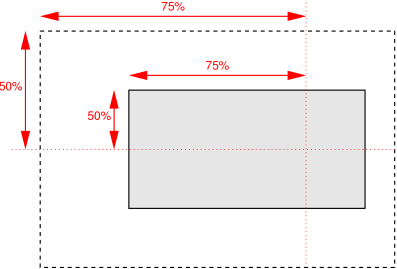
|
If specified on a tt element, then, if a
related media object exists, the positioning rectangle corresponds with
the related media object region, or, if no
related media object exists, the positioning rectangle corresponds with
an unspecified presentation region determined by the document processing context.
For other applicable element types, the positioning rectangle corresponds with the content rectangle (content box)
of the root container region.
Note:
The root container region has no border or padding; consequently, its border, padding, and
content rectangles (boxes) are coterminous.
If a horizontal or vertical position offset is specified by a tts:position attribute in the form of a scalar value
on a tt element, then that value must be expressed using pixel (px) units,
in which case a pixel must be interpreted as a pixel in the presentation context coordinate space
(and not a pixel in the document coordinate space).
If a tts:position attribute is specified on a div or
p element, then that specification must be considered to be
equivalent to specifying an anonymous inline region child of the div or p element, where the
position of the corresponding region, also referred to as an implied inline region, is equal to the
value of this attribute.
If a computed value of the property associated with this attribute is not supported,
then a presentation processor must use the closest supported value.
Note:
In this context, the phrase closest supported value means the value for which the Euclidean distance between
the computed position and the supported position is minimized. If there are multiple closest supported values equally distant from
the computed value, then the value least distant from [0,0], i.e., closest to the coordinate space position, is used.
The tts:position style is illustrated by the following example, which positions a region so that it is
centered in the horizontal dimension and has a bottom edge 10% above the bottom of the positioning rectangle in the vertical dimension.
Example Fragment – Position
<region xml:id="r1">
<style tts:position="center bottom 10%"/>
<style tts:extent="308px 92px"/>
<style tts:backgroundColor="black"/>
<style tts:color="white"/>
<style tts:displayAlign="center"/>
<style tts:textAlign="center"/>
</region>
...
<p region="r1">
"To dine!" she shrieked in dragon-wrath.<br/>
"To swallow wines all foam and froth!<br/>
To simper at a table-cloth!"
</p>
|
| Editorial note: Position Example Image | 2014-11-28 |
| Insert image of position example. |
Note:
The semantics of the style property represented by this attribute are based upon
the background-position property defined by [CSS Backgrounds and Borders], § 3.6.
10.2.33 tts:ruby
The tts:ruby attribute is used to specify the application of ruby
styling.
This attribute may be specified by any element type that permits use of attributes in the TT Style Namespace; however,
this attribute applies as a style property only to those element types indicated in the following table.
| Values: |
none |
container |
base |
baseContainer |
text |
textContainer |
delimiter
|
| Initial: | none |
| Applies to: |
span
|
| Inherited: | no |
| Percentages: | N/A |
| Animatable: | discrete |
If the value of this attribute is none, then no ruby semantics apply; otherwise, the ruby semantics enumerated by
Table 8-1 – Ruby Semantics Mapping apply.
If a computed value of the property associated with this attribute is not supported,
then a presentation processor must use the value none.
Table 8-1 – Ruby Semantics Mapping| Category | tts:ruby | Annotation [Ruby] | CSS display [CSS Ruby] |
|---|
| Ruby Container | container | ruby | ruby |
| Ruby Base Content | base | rb | ruby-base |
| Ruby Text Content | text | rt | ruby-text |
| Ruby Base Container | baseContainer | rbc | ruby-base-container |
| Ruby Text Container | textContainer | rtc | ruby-text-container |
| Ruby Fallback Delimiter | delimiter | rp | none | inline |
When using tts:ruby, the following nesting constraints apply:
| Editorial note: Proscribe Non-Ruby Span Children in Container | 2015-02-18 |
| Add constraints to proscribe use of span children of container that do not specify a ruby style, i.e., that
do not play a role in ruby structure. If used, then such span is ignored for presentation purposes. |
| Editorial note: Proscribe Extraneous #PCDATA in Container | 2015-02-18 |
| Add constraints to proscribe #PCDATA node children of container, baseContainer, and textContainer; i.e., permit #PCDATA only
in base, text, and delimiter. If used, then such data is ignored for presentation purposes. |
| Editorial note: Proscribe Break Element in Container | 2015-02-18 |
Add constraint to proscribe use of br element in ruby or its descendants, and, if used, is interpreted as normal
(collapsible) whitespace. |
| Editorial note: Proscribe Line Separator and Paragraph Separator Characters in Container | 2015-02-18 |
| Add constraint to proscribe use of U+2028 (LINE SEPARATOR) and U+2029 (PARAGRAPH SEPARATOR) in ruby or its descendants, and, if used, they are
interpreted as normal (collapsible) whitespace. |
if the computed value of tts:ruby is container, then the
computed value of tts:ruby of all ancestor elements is none;
if the computed value of tts:ruby is container, then the
computed value of tts:ruby of its first child element is baseContainer
or base;
if the computed value of tts:ruby is baseContainer, then the
computed value of tts:ruby of its parent element is container;
if the computed value of tts:ruby is baseContainer, then the
computed value of tts:ruby of its first child element is base;
if the computed value of tts:ruby is baseContainer, then its
preceding sibling is null (i.e., no preceding sibling);
if the computed value of tts:ruby is textContainer, then the
computed value of tts:ruby of its parent element is container;
if the computed value of tts:ruby is textContainer, then the
computed value of tts:ruby of its first child element is either text or delimiter;
if the computed value of tts:ruby is textContainer, then the
computed value of tts:ruby of its preceding sibling is baseContainer or
textContainer;
if the computed value of tts:ruby is textContainer, then the
computed value of tts:ruby of no more than one sibling is textContainer;
if the computed value of tts:ruby is base, then the
computed value of tts:ruby of its parent element is either container or
baseContainer;
if the computed value of tts:ruby is base, then its
preceding sibling is either null (i.e., no preceding sibling) or the
computed value of tts:ruby of its preceding sibling is base;
if the computed value of tts:ruby is base and the
computed value of tts:ruby of its parent element is container,
then the computed value of tts:ruby of no sibling is base;
if the computed value of tts:ruby is base, then the
computed value of tts:ruby of no descendant element is not none;
if the computed value of tts:ruby is text, then the
computed value of tts:ruby of its parent element is either container or
textContainer;
if the computed value of tts:ruby is text, then the
computed value of tts:ruby of its preceding sibling is base,
text, or delimiter;
if the computed value of tts:ruby is text and the
computed value of tts:ruby of its parent element is container,
then the computed value of tts:ruby of no sibling is text;
if the computed value of tts:ruby is text, then the
computed value of tts:ruby of no descendant element is not none;
if the computed value of tts:ruby is delimiter, then the
computed value of tts:ruby of its parent element is either container or textContainer;
if the computed value of tts:ruby is delimiter, then the
computed value of tts:ruby of its preceding sibling is base or
text;
if the computed value of tts:ruby is delimiter, then the
computed value of tts:ruby of exactly one sibling is delimiter;
if the computed value of tts:ruby is delimiter, then the
computed value of tts:ruby of no descendant element is not none;
A validating processor must treat a violation of any of the above constraints as an error.
For the purpose of presentation processing, the violation of any of these constraints should result in fallback (inline)
presentation of ruby text annotations.
When performing normal presentation processing of ruby text annotations, delimiter content must not generate any
inline areas. When performing fallback presentation of ruby, both delimiter and non-delimiter ruby (base and text) content
must generate normal inline areas.
If a presentation processor does not support ruby presentation, then it must perform fallback ruby presentaton.
Note:
The above listed constraints are intended to be interpreted as specifying the following nesting model:
container
: base text
| base delimiter text delimiter
| baseContainer textContainer textContainer?
baseContainer
: base+
textContainer
: text+
| delimiter text+ delimiter
base | text | delimiter
: ( #PCDATA | { span - tts:ruby } )*
This model corresponds to the maximal content model for the ruby element defined by [Ruby], §2.1,
with the exception that rtc is effectively extended to permit the optional use of delimiters (rp):
ruby
: rb rt
| rb rp rt rp
| rbc rtc rtc?
rbc
: rb+
rtc
: rt+
| rp rt+ rp // extension to [Ruby]
Note:
While not supporting as many opportunities for markup minimization as allowed by [HTML5],
the formulation of ruby annotation defined here does allow the following shorthands:
base text =
baseContainer
base
textContainer
text
base delimiter text delimiter =
baseContainer
base
textContainer
delimiter text delimiter
Given the content of base is B and the content of
text is T, then the expression base text could be represented variously in [HTML5] as follows:
<ruby>B<rt>T</ruby>
<ruby>B<rt>T</rt></ruby>
<ruby><rb>B<rt>T</ruby>
<ruby><rb>B</rb><rt>T</ruby>
<ruby><rb>B</rb><rt>T</rt></ruby>
<ruby>B<rtc><rt>T</ruby>
<ruby>B<rtc><rt>T</rtc></ruby>
<ruby>B<rtc><rt>T</rt></ruby>
<ruby>B<rtc><rt>T</rt></rtc></ruby>
<ruby><rb>B<rtc><rt>T</ruby>
<ruby><rb>B<rtc><rt>T</rtc></ruby>
<ruby><rb>B</rb><rtc><rt>T</ruby>
<ruby><rb>B</rb><rtc><rt>T</rtc></ruby>
<ruby><rb>B</rb><rtc><rt>T</rt></ruby>
<ruby><rb>B</rb><rtc><rt>T</rt></rtc></ruby>
Whereas, in TTML2, the following alternative expressions are possible:
<span tts:ruby="container">
<span tts:ruby="base">B</span>
<span tts:ruby="text">T</span>
</span>
or its equivalent
<span tts:ruby="container">
<span tts:ruby="baseContainer">
<span tts:ruby="base">B</span>
</span>
<span tts:ruby="textContainer">
<span tts:ruby="text">T</span>
</span>
</span>
Use of tts:ruby to specify simple ruby annotation is illustrated by the following example.
Example Fragment – Simple Ruby
<span tts:ruby="container">
<span tts:ruby="base">利用許諾</span>
<span tts:ruby="text">ライセンス</span>
</span>
|
Example Rendition – Simple Ruby |
Use of tts:ruby to specify complex ruby annotation is illustrated by the following example.
Example Fragment – Complex Ruby
<span>
<span tts:ruby="container">
<span tts:ruby="baseContainer">
<span tts:ruby="base">東南</span>
</span>
<span tts:ruby="textContainer" tts:rubyPosition="before">
<span tts:ruby="text">とうなん</span>
</span>
<span tts:ruby="textContainer" tts:rubyPosition="after">
<span tts:ruby="text">たつみ</span>
</span>
</span>
<span>の方角</span>
</span>
|
Example Rendition – Complex Ruby |
Note:
The semantics of the style property
represented by this attribute are based upon that defined by [Ruby] and [CSS Ruby]. See also
[JLREQ], §3.3, for further information.
10.2.34 tts:rubyAlign
The tts:rubyAlign attribute is used to specify the position of ruby text within the inline area generated by the ruby text container annotation.
This attribute may be specified by any element type that permits use of attributes in the TT Style Namespace; however,
this attribute applies as a style property only to those element types indicated in the following table.
| Values: |
auto |
start |
center |
end |
spaceAround |
spaceBetween |
withBase
|
| Initial: | auto |
| Applies to: |
span only if the computed value of tts:ruby is container
|
| Inherited: | yes |
| Percentages: | N/A |
| Animatable: | discrete |
Let IR and IB be, respectively, the inline areas generated by (1) a ruby text container or
ruby text annotation and (2) an associated ruby base container or ruby base. Further, let NR
and NB, be, respectively, the number of glyph area descendants of these inline areas.
If the value of this attribute is auto, then if NR equals
NB, the semantics of withBase apply; otherwise, if NR is less than
NB, the semantics of spaceAround or spaceBetween apply, respectively, according to whether
NB is less than or equal to one (1) or is greater than one;
otherwise (NR is greater than NB),
the semantics of center apply.
If the value of this attribute is start, then the start edge of the first glyph area descendant of IR
is aligned to the start edge of that inline area.
If the value is center, then excess whitespace
is equally distributed before and after the first and last ruby annotation glyph areas, respectively.
If the value of this attribute is end, then the end edge of the first glyph area descendant of IR
is aligned to the end edge of that inline area.
If the value is spaceBetween, then excess whitespace
is equally distributed between each ruby annotation glyph area.
If the value is spaceAround, then excess whitespace
is equally distributed before and after each ruby annotation glyph area descendant.
If the value of this attribute is withBase, then, if NR and NB are equal,
the ith glyph area descendant of
IR is center aligned (horizontally or vertically) with the ith glyph area descendant of
IB;
otherwise (the number of ruby and base glyph areas are not equal), the semantics of center apply.
For the purpose of interpreting glyph area descendant in the context of the above semantics, only spacing glyph area
descendants are considered; i.e., non-spacing glyph area descendants, such as combining marks, have no impact on ruby alignment.
If a computed value of the property associated with this attribute is not supported,
then a presentation processor must use the value auto.
The tts:rubyAlign style is illustrated by the following example.
Example Fragment – Ruby Align
<styling>
<style xml:id="s3" tts:ruby="container"/>
<style xml:id="s4" tts:ruby="base"/>
<style xml:id="s5" tts:ruby="text"/>
</styling>
...
<p>
<span style="s3" tts:rubyAlign="start"><span style="s4">自業自得</span><span style="s5">一二三</span></span>
<span style="s3" tts:rubyAlign="spaceAround"><span style="s4">自業自得</span><span style="s5">一二三</span></span><br/>
<span style="s3" tts:rubyAlign="end"><span style="s4">自業自得</span><span style="s6">一二三</span></span>
<span style="s3" tts:rubyAlign="spaceBetween"><span style="s4">自業自得</span><span style="s6">一二三</span></span>
</p>
|
Example Rendition – Ruby Align |
Note:
The semantics of the style property
represented by this attribute are based upon and extend the semantics defined by [CSS Ruby], §4.3, and the examples and example
renderings shown there apply.
10.2.35 tts:rubyOffset
The tts:rubyOffset attribute is used to specify the offset (distance) of ruby text with respect to its associated ruby base
in the block progression dimension.
| Editorial note: Auto Ruby Offset | 2015-02-18 |
Add auto value to denote automatic offset determination. Change initial value to auto. |
This attribute may be specified by any element type that permits use of attributes in the TT Style Namespace; however,
this attribute applies as a style property only to those element types indicated in the following table.
| Values: |
<length>
|
| Initial: | 0px |
| Applies to: |
span only if the computed value of tts:ruby is container
|
| Inherited: | yes |
| Percentages: | relative to this element's font size |
| Animatable: | continuous |
If specified, the value of tts:rubyOffset expresses the offset (distance) between padding edge E1 of the inline area
generated by a ruby text container (explicit or implied) and padding edge E2 of the inline area generated by a ruby base container (explicit or implied), where
E1 and E2 are perpendicular to the block progression direction and are (or would be) adjacent in the absence of
such an offset.
Negative length expressions are permitted.
| Editorial note: Ruby Offset Example | 2014-10-02 |
| Add example source and rendering of tts:rubyOffset. |
10.2.36 tts:rubyOverflow
The tts:rubyOverflow attribute is used to specify constraint resolution rules for handling certain edge effects
involving ruby text in potential overflow scenarios. For example, if the inline progression dimension of a ruby text area exceeds the
inline progression dimension of its associated base text, and that base text appears at the start or end edge of a line area, then
the ruby text may potentially overflow its containing block area depending on the applicable ruby text alignment as determined by
the tts:rubyAlign style property.
This attribute may be specified by any element type that permits use of attributes in the TT Style Namespace; however,
this attribute applies as a style property only to those element types indicated in the following table.
| Values: |
shiftRuby |
shiftBase |
overflow
|
| Initial: | shiftRuby |
| Applies to: |
span only if the computed value of tts:ruby is container.
|
| Inherited: | yes |
| Percentages: | N/A |
| Animatable: | discrete |
If specified, the value of tts:rubyOverflow expresses how to resolve potential overflow scenarios where ruby text
may otherwise overflow its containing block in line start or end edge contexts.
If the value of this attribute is overflow, then ruby text in these line edge contexts is allowed to overflow its containing block,
in which case the semantics of tts:overflow apply; that is, both base text to line edge alignment and
ruby text to base text alignment is preserved, while allowing the ruby text to overflow the containing block area.
If the value of this attribute is shiftBase, then overflow is prevented by relaxing the base text to line edge alignment by
inseting the base text while preserving ruby text to base alignment.
If the value of this attribute is shiftRuby, then overflow is prevented by relaxing the ruby text to base text alignment by
inseting the ruby text while preserving base text to line edge alignment. When inseting ruby text, the semantics of
tts:overHang apply for the purpose of determining whether and how much overhang is permitted between the inset ruby text and
adjacent base text.
When inseting ruby text or base text in order to resolve a potential overflow scenario, only the minimum (non-negative) inset is applied.
| Editorial note: Ruby Overflow Example | 2016-04-29 |
| Add example source and rendering of tts:rubyOverflow. |
Note:
The semantics of the style property represented by this attribute are intended to provide authorial
control over the special cases of ruby presentation described in
[JLREQ], §3.3.8, Adjustments of Ruby with Length Longer than that of the Base Characters,
and [CSS Ruby], §5, Edge Effects.
10.2.37 tts:rubyOverhang
The tts:rubyOverhang attribute is used to specify constraint resolution rules for handling potential cases of overhang between
ruby text and adjacent base text, where by adjacent base text is meant baseline aligned inline content that is immediately adjacent to
the base text associated with the ruby text. In the case where the inline progression dimension of the ruby text exceeds the
inline progression dimension of its associated base text, or in ruby overflow cases where the ruby text must be inset, then it is possible
that the ruby text may overhang content set on the baseline that is not part of the ruby text's associated base text. In such
cases, the tts:rubyOverhang attribute may be used to determine whether and how much overhang is allowed to occur.
This attribute may be specified by any element type that permits use of attributes in the TT Style Namespace; however,
this attribute applies as a style property only to those element types indicated in the following table.
| Values: |
none |
allow |
always |
overlap
|
| Initial: | allow |
| Applies to: |
span only if the computed value of tts:ruby is
container. |
| Inherited: | yes |
| Percentages: | N/A |
| Animatable: | discrete |
If specified, the value of tts:rubyOverhang expresses how to resolve potential overhang scenarios where ruby text
may otherwise overhang adjacent base text.
If the value of this attribute is none, then overhang is prevented by inserting filler space before and/or after the
base text associated with the ruby text. When inserting such filler (space), only the minimum (non-negative) filler is applied to prevent overlap.
If the value of this attribute is allow, then overhang is allowed to occur in accordance with the semantics
of tts:rubyOverhangClass while preventing overlap between adjacent ruby text containers.
If the value of this attribute is always, then apply the semantics of allow such that
the overhang class is the character class containing all characters.
If the value of this attribute is overlap, then apply the semantics of always except that no filler
is inserted in order to prevent overlap between adjacent ruby text containers. In this case, the author would need to explcitly insert
significant white space or filler in order to prevent overlap.
| Editorial note: Ruby Overhang Example | 2016-04-29 |
| Add example source and rendering of tts:rubyOverhang. |
Note:
The semantics of the style property represented by this attribute are intended to provide authorial
control over the special cases of ruby presentation described in
[JLREQ], §3.3.8, Adjustments of Ruby with Length Longer than that of the Base Characters,
and [CSS Ruby], §5, Edge Effects.
10.2.38 tts:rubyOverhangClass
The tts:rubyOverhangClass attribute is used to provide fine-grained control over the semantics of
the style property expressed by the tts:rubyOverhang attribute. In particular, it used to specify the set
of base text characters which accept overhanging ruby text. If a base text character is not in this specified set, then ruby
text is prevented from overhanging that character.
This attribute may be specified by any element type that permits use of attributes in the TT Style Namespace; however,
this attribute applies as a style property only to those element types indicated in the following table.
If specified, the value of tts:rubyOverhangClass expresses constraints on which base characters allow ruby text to overhang them.
If the value of this attribute is auto, then the character class that permits overhang is implementation dependent; however, the
following recommendations apply in the absence of more specific implementation requirements:
If the language of the base text is specified or can be inferred as Japanese, then auto should be interpreted as if the following
were specified: ideographic hiragana punctuationMarks.
If the language of the base text is specified or can be inferred as Chinese or Korean, then auto should be interpreted as if the
following were specified: ideographic.
If a base character is encountered that is not in the computed value of the tts:rubyOverhangClass, then ruby text must not overhang
that character.
| Editorial note: Ruby Overhang Class Example | 2016-04-29 |
| Add example source and rendering of tts:rubyOverhangClass. |
Note:
The semantics of the style property represented by this attribute are intended to provide authorial
control over the special cases of ruby presentation described in
[JLREQ], §3.3.8, Adjustments of Ruby with Length Longer than that of the Base Characters,
and [CSS Ruby], §5, Edge Effects.
10.2.39 tts:rubyPosition
The tts:rubyPosition attribute is used to specify the position of ruby text in the block progression dimension
with respect to its associated ruby base.
| Editorial note: Outside Annotations | 2015-01-14 |
Add auto and outside values as defined by <emphasis-position> expressions. |
This attribute may be specified by any element type that permits use of attributes in the TT Style Namespace; however,
this attribute applies as a style property only to those element types indicated in the following table.
| Values: |
before |
after
|
| Initial: | before |
| Applies to: |
span only if the computed value of tts:ruby is container
|
| Inherited: | yes |
| Percentages: | N/A |
| Animatable: | discrete |
If the value of this attribute is before, then an inline area generated from a ruby text container or ruby text annotation
is placed before (prior to) the first edge in the block progression dimension of the inline area generated from an associated ruby base container or ruby base annotation.
If the value is after, then an inline area generated from a ruby text container or ruby text annotation
is placed after (subsequent to) the second edge in the block progression dimension of the inline area generated from an associated ruby base container or ruby base
annotation.
The absolute position of the ruby text container or ruby text annotation is determined
in accordance to the computed value of the tts:writingMode style property of the region into which the affected content is placed; in particular, the
mappings defined enumerated by Table 8-2 – Ruby Position Semantics Mapping by Writing Mode apply as further defined by [CSS Ruby], §4.1.
If a computed value of the property associated with this attribute is not supported,
then a presentation processor must use the value before.
Table 8-2 – Ruby Position Semantics Mapping by Writing Mode| tts:rubyPosition | lrtb | rltb | tbrl | tblr |
|---|
before | over | over | right | left |
after | under | under | left | right |
The tts:rubyPosition style is illustrated by the following example.
Example Fragment – Ruby Position
<styling>
<style xml:id="s3" tts:ruby="container"/>
<style xml:id="s4" tts:ruby="base"/>
<style xml:id="s5" tts:ruby="text"/>
</styling>
...
<p region="tblr">
<span style="s3" tts:rubyPosition="before">
<span style="s4">一二</span>
<span style="s5">一二</span>
</span>三四<br/>五六
<span style="s3" tts:rubyPosition="after">
<span style="s4">七八</span>
<span style="s5">七八</span>
</span>
</p>
<p region="lrtb">
<span style="s3" tts:rubyPosition="before">
<span style="s4">一二</span>
<span style="s5">一二</span>
</span>三四<br/>五六
<span style="s3" tts:rubyPosition="after">
<span style="s4">七八</span>
<span style="s5">七八</span>
</span>
</p>
<p region="tbrl">
<span style="s3" tts:rubyPosition="before">
<span style="s4">一二</span>
<span style="s5">一二</span>
</span>三四<br/>五六
<span style="s3" tts:rubyPosition="after">
<span style="s4">七八</span>
<span style="s5">七八</span>
</span>
</p>
|
Example Rendition – Ruby Position |
Note:
The semantics of the style property
represented by this attribute are based upon that defined by [CSS Ruby], §4.1, and the examples and example
renderings shown there apply modulo the mappings defined above.
10.2.40 tts:rubyReserve
The tts:rubyReserve attribute is used to specify additional space to apply to affected line
areas in order to reserve sufficient room in the block progression dimension to contain inline areas generated by ruby text containers placed within
the bounds of the line areas.
Note:
An author may use the tts:rubyReserve attribute in order to ensure that consecutive baselines of line areas in a block area retain a fixed
placement regardless of the presence or absence of ruby text annotations.
This attribute may be specified by any element type that permits use of attributes in the TT Style Namespace; however,
this attribute applies as a style property only to those element types indicated in the following table.
| Values: |
none |
[
auto |
before |
after |
both |
outside |
around |
between
]
<length>?
|
| Initial: | none |
| Applies to: |
p
|
| Inherited: | yes |
| Percentages: | relative to this element's font size |
| Animatable: | discrete |
If the value of this attribute is none, then no ruby space reservation applies; otherwise, the value of this attribute specifies a
position component followed by an optional length component.
If the position component is auto, then, if the current block area contains exactly two line areas, the outside position
applies, otherwise the around position applies.
If the position component is before, then the before leading of affected line areas is increased by the amount determined by the
used value of the length component.
If the position component is after, then the after leading of affected line areas is increased by the amount determined by the
used value of the length component.
If the position component is both, then the semanitcs of both the before and after positions apply
to each affected line area.
If the position component is outside, then the semantics of the before position apply to the first line area of the current
block area and the semantics of the after position apply to the last line area of the current block area. If only one line area is present
in the current block area, then both before and after positions apply to that line area.
If the position component is around, then the semantics of the before position apply to all affected line areas.
In addition, the semantics of the after position apply to the last line area of the current block area.
If the position component is between, then the semantics of the before position apply to the second and subsequent
affected line arease of the current block area, or, if only one line area is present in the current block area, no ruby space reservation applies
to that line area.
If the length component is specified, then its used value determines an amount by which the before or (and) after leading(s) of an
affected line area are increased. If no length component is specified, then it must be considered as if the length component were specified
with a value equal to one half of the used value of the tts:lineHeight style property that applies to the current
p element.
If the <length> component is specified, it must be non-negative.
Example Renditions – Ruby Reservetts:rubyReserve | No Ruby Present | Ruby Present |
|---|
none |  |  |
auto |  |  |
before |  |  |
after |  |  |
both |  | 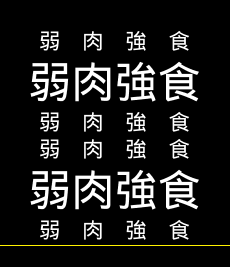 |
outside |  |  |
around |  |  |
between |  |  |
10.2.41 tts:showBackground
The tts:showBackground attribute is used to specify
constraints on when the background color of a region is intended to be
presented.
This attribute may be specified by any
element type
that permits use of attributes in the TT Style Namespace; however, this attribute applies
as a style property only to those element types indicated in the following table.
| Values: |
always |
whenActive
|
| Initial: | always |
| Applies to: |
region
|
| Inherited: | no |
| Percentages: | N/A |
| Animatable: | discrete |
If the value of this attribute is always, then the
background color of a region is always rendered when performing presentation
processing on a visual medium; if the value is whenActive,
then the background color of a region is rendered only when some
content is flowed into the region.
A region satisfies the whenActive case if (1) it is a
temporally active region and (2) content is selected into the region,
where that content is also temporally active.
If a computed value of the property associated with this attribute is not supported,
then a presentation processor must use the value always.
The tts:showBackground style is illustrated by the following example.
Example Fragment – Show Background
<region xml:id="r1">
<style tts:origin="0px 0px"/>
<style tts:extent="265px 100px"/>
<style tts:backgroundColor="black"/>
<style tts:showBackground="always"/>
<style tts:color="white"/>
<style tts:displayAlign="before"/>
<style tts:textAlign="start"/>
</region>
<region xml:id="r2">
<style tts:origin="205px 60px"/>
<style tts:extent="290px 100px"/>
<style tts:backgroundColor="red"/>
<style tts:color="white"/>
<style tts:displayAlign="before"/>
<style tts:textAlign="end"/>
<style tts:showBackground="whenActive"/>
</region>
|
Note:
The semantics of the style property
represented by this attribute are based upon that defined by [SMIL 3.0],
§ 7.4.2.
10.2.42 tts:textAlign
The tts:textAlign attribute is used to specify a style property that
defines how inline areas are aligned within a containing block area in the inline progression
direction.
| Editorial note: Justification in Inline Progression Dimension | 2015-04-06 |
Add justify value to support justification in inline progression dimension. |
This attribute may be specified by any
element type
that permits use of attributes in the TT Style Namespace; however, this attribute applies
as a style property only to those element types indicated in the following table.
| Values: |
left |
center |
right |
start |
end
|
| Initial: | start |
| Applies to: |
p,
span
|
| Inherited: | see prose |
| Percentages: | N/A |
| Animatable: | discrete |
The tts:textAlign attribute is inheritable only on a p element. If not
specified on a span element, then the tts:textAlign style property does not apply to that
element, rather, normal inline composition and alignment apply.
If a tts:textAlign attribute is specified on a span element,
then that span element must be processed using
inline block display semantics for the purpose of presentation processing.
Note:
A tts:textAlign attribute may be used on a span element in order
to force composition using inline block display semantics and to apply a different alignment
to the resulting nested block area. For example, a paragraph may be composed using center text alignment, while the text content within the paragraph, if
wrapped in a span, may be composed using left text alignment.
If a computed value of the property associated with this attribute is not supported,
then a presentation processor must use the value start.
The tts:textAlign style is illustrated by the following example.
Example Fragment – Text Align
<region xml:id="r1">
<style tts:extent="355px 43px"/>
<style tts:origin="0px 0px"/>
<style tts:backgroundColor="black"/>
<style tts:color="white"/>
<style tts:textAlign="start"/>
</region>
<region xml:id="r2">
<style tts:extent="355px 43px"/>
<style tts:origin="0px 47px"/>
<style tts:backgroundColor="black"/>
<style tts:color="white"/>
<style tts:textAlign="end"/>
</region>
...
<p region="r1">
Beware the Jabberwock, my son!<br/>
The jaws that bite, the claws that catch!
</p>
<p region="r2">
Beware the Jubjub bird, and shun<br/>
The frumious Bandersnatch!
</p>
|
Example Rendition – Text Align |
Example Fragment – Differing Text Align on p and span
<region xml:id="r1">
<style tts:extent="446px 72px"/>
<style tts:origin="0px 0px"/>
<style tts:backgroundColor="green"/>
<style tts:color="white"/>
<style tts:textAlign="start"/>
<style tts:displayAlign="center"/>
</region>
<region xml:id="r2">
<style tts:extent="446px 72px"/>
<style tts:origin="0px 76px"/>
<style tts:backgroundColor="black"/>
<style tts:color="white"/>
<style tts:textAlign="center"/>
<style tts:displayAlign="center"/>
</region>
...
<p region="r1">
<span tts:textAlign="end">
span textAlign="end"<br/>
p textAlign="start"
</span>
</p>
<p region="r2">
<span tts:textAlign="start">
span textAlign="start"<br/>
p textAlign="center"
</span>
</p>
|
Example Rendition – Differing Text Align on p and span |
Note:
The semantics of the style property
represented by this attribute are based upon that defined by [XSL 1.1],
§ 7.16.9.
10.2.43 tts:textCombine
When a vertical writing mode applies, the tts:textCombine attribute is used to specify a style property that
determines whether and how multiple nominally non-combining characters are combined so that their glyph areas
consume the nominal bounding box of a single em square of the surrounding vertical text.
If a horizontal writing mode applies, then this property is ignored
for the purpose of presentation processing.
Combination processing may make use of one or more techniques to obtain the goal of visual combination into an em square of the surrounding vertical text.
For example, half-width variant forms may be selected, a ligature may be selected, a smaller font size may be applied, etc. At a minimum, an
implementation that supports this style property must be able to select half-width variant forms if available. If none of these techniques are
able to achieve the target dimension along the block progression dimension of the containing line area, then this dimension of the containing line area may be increased if
permitted by the line stacking strategy in effect.
This attribute may be specified by any
element type
that permits use of attributes in the TT Style Namespace; however, this attribute applies
as a style property only to those element types indicated in the following table.
| Values: |
none |
all |
[ digits <non-negative-integer>? ]
|
| Initial: | none |
| Applies to: |
span
|
| Inherited: | yes |
| Percentages: | N/A |
| Animatable: | discrete |
For the purpose of determining applicability of this style property,
each character child of a p element is considered to be enclosed in an anonymous
span.
If the specified value of this attribute is none, then no combination processing applies.
If the specified value of this attribute is all, then all affected characters should be combined.
If the specified value of this attribute is digits, then all affected characters should be combined if they are a sequence of a digits which length is
equal to or less than a specified count, or two (2) if no count is specified.
Combination must not cross an element boundary, a bidirectional boundary, or a non-glyph area boundary.
This attribute has no impact on or interaction with the nominal layout of glyph areas that constitute a Unicode combining character sequence.
| Editorial note: Text Combine Example | 2015-01-05 |
| Insert example fragment and image of tts:textCombine. |
Note:
The semantics of the style property represented by this attribute are based upon
that defined by [CSS Writing Modes], § 9.1.
10.2.44 tts:textDecoration
The tts:textDecoration attribute is used to specify a style property that
defines a text decoration effect to apply to glyph areas or other inline
areas that are generated by content flowed into a region.
This attribute may be specified by any
element type
that permits use of attributes in the TT Style Namespace; however, this attribute applies
as a style property only to those element types indicated in the following table.
| Values: |
none |
[ [
underline |
noUnderline
] || [
lineThrough |
noLineThrough
] || [
overline |
noOverline
] ]
|
| Initial: | none |
| Applies to: | span |
| Inherited: | yes |
| Percentages: | N/A |
| Animatable: | discrete |
For the purpose of determining applicability of this
style property, each character child of a p element is
considered to be enclosed in an anonymous span.
If a computed value of the property associated with this attribute is not supported,
then a presentation processor must use the value none.
Note:
The syntax used above in defining the value of this property is based on the
value component syntax defined in [CSS2], § 1.4.2.1. In essence,
one or more of the values separated by || may appear in the property
value in any order, such as "noUnderline overline lineThrough".
The tts:textDecoration style is illustrated by the following example.
Example Fragment – Text Decoration
<region xml:id="r1">
<style tts:extent="385px 82px"/>
<style tts:origin="0px 0px"/>
<style tts:backgroundColor="black"/>
<style tts:color="white"/>
<style tts:padding="5px 2px"/>
<style tts:textDecoration="underline"/>
</region>
...
<p region="r1">
The sea was wet<span tts:textDecoration="noUnderline"> as </span>wet
<span tts:textDecoration="noUnderline">
could be,<br/>
The sand was dry as dry.<br/>
<span tts:textDecoration="lineThrough">There weren't any</span>
You <span tts:textDecoration="lineThrough">couldn't</span>
could not see a cloud<br/>
Because no cloud was in the sky.
</span>
</p>
|
Example Rendition – Text Decoration |
Note:
The semantics of the style property
represented by this attribute are based upon that defined by [XSL 1.1],
§ 7.17.4.
10.2.45 tts:textEmphasis
The tts:textEmphasis attribute is used to specify a style property that
determines whether and how text emphasis marks are presented on affected content.
This attribute may be specified by any
element type
that permits use of attributes in the TT Style Namespace; however, this attribute applies
as a style property only to those element types indicated in the following table.
For the purpose of determining applicability of this style property,
each character child of a p element is considered to be enclosed in an anonymous
span.
If the specified value of this attribute is auto, then it must be interpreted as if
auto were specified for both emphasis style and emphasis position components.
If no emphasis style is specified,
then the emphasis style must be interpreted as if a style of auto were specified.
If no emphasis color is specified,
then the emphasis color must be interpreted as if a color of current were specified.
If no emphasis position is specified,
then the emphasis position must be interpreted as if a position of auto were specified.
The tts:textEmphasis style is illustrated by the following example.
Example Fragment – Text Emphasis
<p>
<span tts:textEmphasis="filled circle before">花</span>
<span tts:textEmphasis="filled dot before">よ</span>
<span tts:textEmphasis="filled sesame before">り</span>
<span tts:textEmphasis="open circle before">だ</span>
<span tts:textEmphasis="open dot before">ん</span>
<span tts:textEmphasis="open sesame before">ご</span>
</p>
|
Example Rendition – Text Emphasis |
Note:
The semantics of the style property represented by this attribute are based upon
that defined by [CSS Text Decoration], § 3.
10.2.46 tts:textOrientation
The tts:textOrientation attribute is used to specify a style property that
defines a text orientation to apply to glyphs that are selected for glyph areas generated
by content flowed into a region to which a vertical writing mode applies.
This attribute may be specified by any
element type
that permits use of attributes in the TT Style Namespace; however, this attribute applies
as a style property only to those element types indicated in the following table.
| Values: |
mixed |
sideways |
sidewaysLeft |
sidewaysRight |
upright
|
| Initial: | mixed |
| Applies to: |
span
|
| Inherited: | yes |
| Percentages: | N/A |
| Animatable: | discrete |
For the purpose of determining applicability of this style property,
each character child of a p element is considered to be enclosed in an anonymous
span.
If the value of this attribute is mixed, then, in vertical writing modes,
glyphs from horizontal scripts are set sideways, i.e., 90° clockwise from
their nominal orientation in horizontal text, while glyphs from vertical scripts are not
affected.
If the value of this attribute is sidewaysLeft, then, in vertical writing modes,
glyphs from horizontal scripts are set sideways with 90° counter-clockwise rotation.
If the value of this attribute is sidewaysRight, then, in vertical writing modes,
glyphs from horizontal scripts are set sideways with 90° clockwise rotation.
If the value of this attribute is sideways, then, in vertical writing modes,
glyphs from horizontal scripts are set sideways, either 90° clockwise or
90° counter-clockwise, according to whether the writing mode is
tbrl or tblr, respectively. Glyphs from vertical scripts are not
affected.
If the value of this attribute is upright, then, in vertical writing modes,
glyphs from horizontal scripts are set upright, i.e., using their
nominal orientation in horizontal text, while glyphs from vertical scripts are not
affected. In addition, for purposes of bidirectional processing, this value causes all
affected characters to be treated as strong left-to-right, i.e., to be treated as if
a tts:direction of ltr and tts:unicodeOverride of
override were applied.
If a vertical writing mode does not apply, then this style property has no effect.
If a computed value of the property associated with this attribute is not supported,
then a presentation processor must use the value mixed.
The tts:textOrientation style is illustrated by the following
example.
| Editorial note: Text Orientation Example | 2013-08-24 |
| Insert example fragment and image of tts:textOrientation. |
Note:
The semantics of the style property
represented by this attribute are based upon that defined by [CSS Writing Modes],
§ 5.1.
10.2.47 tts:textOutline
The tts:textOutline attribute is used to specify a style property that
defines a text outline effect to apply to glyphs that are selected for glyph areas generated
by content flowed into a region.
This attribute may be specified by any
element type
that permits use of attributes in the TT Style Namespace; however, this attribute applies
as a style property only to those element types indicated in the following table.
| Values: |
none |
<color>?
<length>
<length>?
|
| Initial: | none |
| Applies to: |
span
|
| Inherited: | yes |
| Percentages: | relative to this element's font size |
| Animatable: | discrete, continuous |
For the purpose of determining applicability of this style property,
each character child of a p element is considered to be enclosed in an anonymous
span.
The value of this attribute consists of an optional <color> term
followed by one or two <length> terms. If a color term is
present, then it denotes the outline color; if no color term is
present, the computed value of the tts:color applies. The first
length term denotes the outline thickness and the second length
term, if present, indicates the blur radius.
The <length> value(s) used to express thickness and blur radius must be non-negative.
Note:
When a <length> expressed in
cells is used in a tts:textOutline value,
the cell's dimension in the block progression dimension applies.
For example, if text outline thickness is specified as 0.1c, the cell resolution
is 20 by 10, and the extent of the root container region is 640 by 480, then the
outline thickness will be a nominal 480 / 10 * 0.1 pixels, i.e., 4.8px,
without taking into account rasterization effects.
If a computed value of the property associated with this attribute is not supported,
then a presentation processor must use the value none.
The tts:textOutline style is illustrated by the following
example.
Example Fragment – Text Outline
<region xml:id="r1">
<style tts:backgroundColor="transparent"/>
<style tts:color="yellow"/>
<style tts:textOutline="black 2px 0px"/>
<style tts:fontFamily="proportionalSansSerif"/>
<style tts:fontSize="24px"/>
</region>
...
<p>
How doth the little crocodile<br/>
Improve its shining tail,<br/>
And pour the waters of the Nile<br/>
On every golden scale!<br/>
How cheerfully he seems to grin,<br/>
How neatly spreads his claws,<br/>
And welcomes little fishes in,<br/>
With gently smiling jaws!
</p>
|
Example Rendition – Text Outline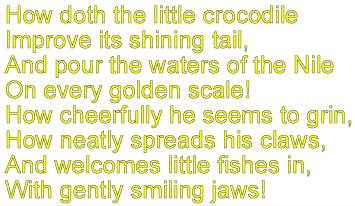 |
10.2.48 tts:textShadow
The tts:textShadow attribute is used to specify a style property that
defines one or more text shadow decorations to apply to glyphs that are selected for glyph areas generated
by content flowed into a region.
If both tts:textOutline and tts:textShadow attributes
are specified on an element and tts:textShadow is a supported property,
then the tts:textOutline attribute must be ignored for the purpose of presentation processing.
If multiple text shadows apply, then they are drawn in the specified order immediately prior to drawing the glyph area to which they apply.
This attribute may be specified by any
element type
that permits use of attributes in the TT Style Namespace; however, this attribute applies
as a style property only to those element types indicated in the following table.
| Values: |
none |
[ <shadow> ]#
|
| Initial: | none |
| Applies to: |
span
|
| Inherited: | yes |
| Percentages: | relative to this element's font size |
| Animatable: | discrete, continuous |
For the purpose of determining applicability of this style property,
each character child of a p element is considered to be enclosed in an anonymous
span.
If a computed value of the property associated with this attribute is not supported,
then a presentation processor must use the value none.
| Editorial note: Text Shadow Example | 2015-01-08 |
| Insert example fragment and image of tts:textShadow. |
Note:
The semantics of the style property represented by this attribute are based upon
that defined by [CSS Text Decoration], § 4.
10.2.49 tts:unicodeBidi
The tts:unicodeBidi attribute is used to specify a style property that
defines a directional embedding or override according to
the Unicode bidirectional algorithm.
This attribute may be specified by any
element type
that permits use of attributes in the TT Style Namespace; however, this attribute applies
as a style property only to those element types indicated in the following table.
| Values: |
normal |
embed |
bidiOverride
|
| Initial: |
normal
|
| Applies to: |
p,
span
|
| Inherited: | no |
| Percentages: | N/A |
| Animatable: | discrete |
For the purpose of determining applicability of this style property,
each character child of a p element is considered to be enclosed in an anonymous
span.
If a computed value of the property associated with this attribute is not supported,
then a presentation processor must use the value normal.
The tts:unicodeBidi style is illustrated by the following example.
Example Fragment – Unicode Bidirectionality
<region xml:id="r1">
<style tts:extent="265px 84px"/>
<style tts:padding="5px"/>
<style tts:backgroundColor="black"/>
<style tts:color="white"/>
<style tts:displayAlign="after"/>
<style tts:textAlign="center"/>
</region>
...
<p region="r1">
Little birds are playing<br/>
Bagpipes on the shore,<br/>
<span tts:unicodeBidi="bidiOverride" tts:direction="rtl">where the tourists snore.</span>
</p>
|
Example Rendition – Unicode Bidirectionality

|
Note:
The semantics of the style property
represented by this attribute are based upon that defined by [XSL 1.1],
§ 7.29.6.
10.2.50 tts:visibility
The tts:visibility attribute is used to specify a style property that
defines whether generated areas are visible or not when rendered on a visual
presentation medium.
This attribute may be specified by any
element type
that permits use of attributes in the TT Style Namespace; however, this attribute applies
as a style property only to those element types indicated in the following table.
| Values: |
visible |
hidden
|
| Initial: |
visible
|
| Applies to: |
body,
div,
p,
region,
span
|
| Inherited: | yes |
| Percentages: | N/A |
| Animatable: | discrete |
For the purpose of determining applicability of this style property,
each character child of a p element is considered to be enclosed in an anonymous
span.
The tts:visibility style has no affect on content layout or
composition, but merely determines whether composed content is visible or not.
If the computed value of the property associated with this attribute is visible, then areas generated by
this element are rendered visible when presented on a visual medium. If the computed value is hidden, then they are not rendered visible,
i.e., they are hidden; notwithstanding the foregoing, a descendant element of a hidden element is rendered visible if the computed value of this property
is visible on the descendant.
If a computed value of the property associated with this attribute is not supported,
then a presentation processor must use the value visible.
The tts:visibility style is illustrated by the following example.
Example Fragment – Visibility
<region xml:id="r1">
<style tts:extent="398px 121px"/>
<style tts:backgroundColor="black"/>
<style tts:color="white"/>
<style/>
</region>
...
<p region="r1" dur="4s">
<span tts:visibility="hidden">
<set begin="1s" tts:visibility="visible"/>
Curiouser
</span>
<span tts:visibility="hidden">
<set begin="2s" tts:visibility="visible"/>
and
</span>
<span tts:visibility="hidden">
<set begin="3s" tts:visibility="visible"/>
curiouser!
</span>
</p>
|
Example Rendition – Visibility

|

|

|

|
Note:
The semantics of the style property
represented by this attribute are based upon that defined by [XSL 1.1],
§ 7.30.17.
10.2.51 tts:wrapOption
The tts:wrapOption attribute is used to specify a style property that
defines whether or not automatic line wrapping (breaking) applies within the context of
the affected element.
This attribute may be specified by any
element type
that permits use of attributes in the TT Style Namespace; however, this attribute applies
as a style property only to those element types indicated in the following table.
| Values: |
wrap |
noWrap
|
| Initial: | wrap |
| Applies to: |
span
|
| Inherited: | yes |
| Percentages: | N/A |
| Animatable: | discrete |
For the purpose of determining applicability of this style property,
each character child of a p element is considered to be enclosed in an anonymous
span.
If a computed value of the property associated with this attribute is not supported,
then a presentation processor must use the value wrap.
The tts:wrapOption style is illustrated by the following example.
Example Fragment – Wrap Option
<region xml:id="r1">
<style tts:extent="192px 117px"/>
<style tts:backgroundColor="black"/>
<style tts:color="white"/>
<style tts:displayAlign="after"/>
<style tts:overflow="hidden"/>
<style tts:wrapOption="noWrap"/>
</region>
...
<p>
I'll tell thee everything I can:<br/>
There's little to relate.<br/>
I saw an aged aged man,<br/>
A-sitting on a gate.
</p>
|
Example Rendition – Wrap Option |
Note:
The semantics of the style property
represented by this attribute are based upon that defined by [XSL 1.1],
§ 7.16.13.
10.2.52 tts:writingMode
The tts:writingMode attribute is used to specify a style property that
defines the block and inline progression directions to be used for the purpose of
stacking block and inline areas within a region area.
This attribute may be specified by any
element type
that permits use of attributes in the TT Style Namespace; however, this attribute applies
as a style property only to those element types indicated in the following table.
| Values: |
lrtb |
rltb |
tbrl |
tblr |
lr |
rl |
tb
|
| Initial: | lrtb |
| Applies to: |
region
|
| Inherited: | no |
| Percentages: | N/A |
| Animatable: | discrete |
If a computed value of the property associated with this attribute is not supported,
then a presentation processor must use the value lrtb.
The tts:writingMode style is illustrated by the following example.
Example Fragment – Writing Mode
<region xml:id="r1">
<style tts:extent="50px 570px"/>
<style tts:origin="0px 0px"/>
<style tts:padding="10px 3px"/>
<style tts:backgroundColor="black"/>
<style tts:color="white"/>
<style tts:writingMode="tbrl"/>
</region>
<region xml:id="r2">
<style tts:extent="310px 50px"/>
<style tts:origin="70px 120px"/>
<style tts:padding="10px 3px"/>
<style tts:backgroundColor="black"/>
<style tts:color="white"/>
<style tts:writingMode="rltb"/>
</region>
...
<p region="r1">
I sometimes dig for buttered rolls,<br/>
Or set limed twigs for crabs:
</p>
<p region="r2" tts:direction="rtl" tts:unicodeBidi="bidiOverride">
I sometimes search the grassy knolls for the wheels of Hansom-cabs.
</p>
|
Example Rendition – Writing Mode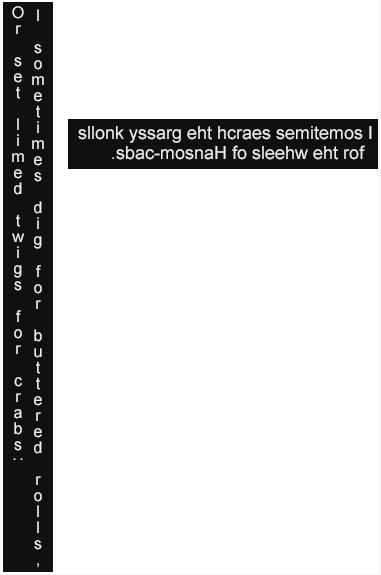 |
Note:
In the second paragraph in the above example that targets region
r2, the tts:unicodeBidi and
tts:direction properties are set to
bidiOverride and rtl, respectively, in order
to override the normally left-to-right directionality of characters in
the Latin script.
Note:
The semantics of the style property
represented by this attribute are based upon that defined by [XSL 1.1],
§ 7.29.7.
10.2.53 tts:zIndex
The tts:zIndex attribute is used to specify a style property that
defines the front-to-back ordering of region areas in the case that they overlap.
This attribute may be specified by any
element type
that permits use of attributes in the TT Style Namespace; however, this attribute applies
as a style property only to those element types indicated in the following table.
| Values: |
auto |
<integer>
|
| Initial: | auto |
| Applies to: |
region
|
| Inherited: | no |
| Percentages: | N/A |
| Animatable: | discrete, continuous (over integral values only) |
If two areas are associated with the same Z-index value, then, if those areas
overlap in space, the area(s) generated by lexically subsequent elements must be
rendered over area(s) generated by lexically prior elements, where lexical
order is defined as the postorder traversal of a document instance.
The semantics of the value auto are those defined by
[XSL 1.1], § 7.30.18, where the tt element
is considered to establish the root stacking context.
If a computed value of the property associated with this attribute is not supported,
then a presentation processor must use the closest supported value.
Note:
In this context, the phrase closest supported value means the value for which the Euclidean distance between
the computed z-index and the supported z-index is minimized. If there are multiple closest supported values equally distant from
the computed value, then the value least distant from 0, i.e., closest to the base stack level of the current stacking context, is used.
The tts:zIndex style is illustrated by the following example.
Example Fragment – Z Index
<region xml:id="r1">
<style tts:origin="0px 0px"/>
<style tts:extent="400px 100px"/>
<style tts:padding="5px"/>
<style tts:backgroundColor="black"/>
<style tts:color="white"/>
<style tts:zIndex="0"/>
</region>
<region xml:id="r2">
<style tts:origin="100px 60px"/>
<style tts:extent="400px 100px"/>
<style tts:padding="5px"/>
<style tts:backgroundColor="red"/>
<style tts:color="white"/>
<style tts:textAlign="end"/>
<style tts:zIndex="1"/>
</region>
<region xml:id="r3">
<style tts:origin="0px 120px"/>
<style tts:extent="400px 100px"/>
<style tts:padding="5px"/>
<style tts:backgroundColor="black"/>
<style tts:color="white"/>
<style tts:zIndex="2"/>
</region>
<region xml:id="r4">
<style tts:origin="100px 180px"/>
<style tts:extent="400px 100px"/>
<style tts:padding="5px"/>
<style tts:backgroundColor="red"/>
<style tts:color="white"/>
<style tts:textAlign="end"/>
<style tts:zIndex="3"/>
</region>
...
<p region="r1">
I passed by his garden, and marked, with one eye,<br/>
How the Owl and the Panther were sharing a pie.
</p>
<p region="r2">
The Panther took pie-crust, and gravy, and meat,<br/>
While the Owl had the dish as its share of the treat.
</p>
<p region="r3">
When the pie was all finished, the Owl, as a boon,<br/>
Was kindly permitted to pocket the spoon:
</p>
<p region="r4">
While the Panther received knife and fork<br/>
with a growl,<br/>
And concluded the banquet by...
</p>
|
Example Rendition – Z Index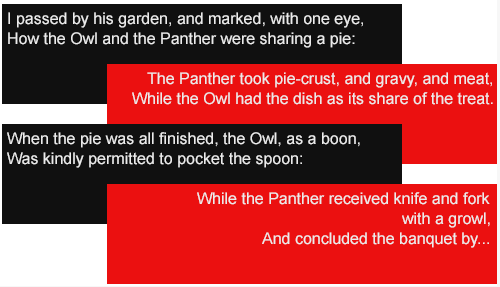 |
Note:
The semantics of the style property
represented by this attribute are based upon that defined by [XSL 1.1],
§ 7.30.18.
10.3 Styling Value Expressions
Style property values include the use of the following expressions:
In the syntax representations defined in this section, no
linear whitespace (LWSP) is implied or permitted between tokens
unless explicitly specified.
10.3.1 <alpha>
An <alpha> expression is used to express an opacity value,
where 0 means fully transparent and 1 means fully opaque.
Syntax Representation – <alpha>|
|
In the above syntax representation, the syntactic element
float must adhere to the lexical
representation defined by [XML Schema Part 2] §
3.2.4.1. If the value represented is less than 0.0,
then it must be interpreted as equal to 0.0; similarly, if the value
represented is greater than 1.0, then it must be interpreted as
1.0. The value NaN must be interpreted as 0.0.
A specified value for <alpha> should not be NaN,
less than 0, or greater than 1.
If a presentation processor does not support a specific,
valid opacity value, then it must interpret it as being equal to the
closest supported value.
Note:
In this context, the phrase closest supported value means the value for which the Euclidean distance between
the computed opacity and the supported opacity is minimized. If there are multiple closest supported values equally distant from
the computed value, then the value most distant from 0, i.e., the greatest opacity, is used.
10.3.2 <border-color>
A <border-color> expression is used to express the color of one
or more borders.
Syntax Representation – <border-color>|
|
10.3.3 <border-radii>
A <border-radii> expression is used to express the radii of one
or more borders.
Syntax Representation – <border-radii>|
|
If two <length> expressions are specified, then the first length
corresponds to the quarter ellipse radius for the inline progression dimension (for content) or
horizontal direction (for regions), while the second length, if present, corresponds to the
quarter ellipse radius for the block progression dimension (for content) or vertical direction
(for regions), or, if only one length is present, then it is interpreted as if two lengths were
specified with the same value.
10.3.4 <border-style>
A <border-style> expression is used to express the style of one
or more borders.
Syntax Representation – <border-style>
<border-style>
: none
| dotted
| dashed
| solid
| double
|
The interpretation of dotted, dashed, and double are considered
to be implementation dependent.
If an implementation does not recognize or otherwise distinguish one of these border style values, then
it must be interpreted as if a style of solid were specified; as such, an implementation that
supports borders must minimally support the solid value.
10.3.5 <border-thickness>
A <border-thickness> expression is used to express the thickness of one
or more borders.
Syntax Representation – <border-thickness>
<border-thickness>
: thin
| medium
| thick
| <length>
|
The interpretation of thin, medium, and thick are considered
to be implementation dependent; however, the resolved lengths must adhere to the following
constraints: thickness(thin) < thickness(medium); thickness(medium) < thickness(thick).
If a border thickness is expressed as a <length>,
then it must not take the form of a percentage value; i.e., it must take the form of a scalar value.
10.3.6 <character-class>
A <character-class> value is used to express an enumerated set of characters.
Syntax Representation – <character-class>
<character-class>
: "[" ( class-character-range | class-character )+ "]"
class-character-range
: class-character "-" class-character
class-character
: unicode-escape
| { char - { specials } }
unicode-escape
: "\\u" hexDigit{6}
| "\\u" hexDigit{4}
| "\\" char
specials
: "-"
| "]"
| "\'"
| "\""
| <whitespace>
|
10.3.7 <color>
A <color> expression is used to specify a named color, exact RGB color triple,
or exact RGBA color tuple, where the alpha component, if expressed,
is maximum (255) at 100% opacity
and minimum (0) at 0% opacity, and where the applicable color space is
defined by [SRGB].
Syntax Representation – <color>
<color>
: "#" rrggbb
| "#" rrggbbaa
| "rgb" "(" r-value "," g-value "," b-value ")"
| "rgba" "(" r-value "," g-value "," b-value "," a-value ")"
| <named-color>
rrggbb
: <hex-digit>{6}
rrggbbaa
: <hex-digit>{8}
r-value | g-value | b-value | a-value
: component-value
component-value
: <non-negative-integer> // valid range: [0,255]
|
When expressing RGB component values, these values are considered
to not be premultiplied by alpha.
For the purpose of performing presentation processing such that
non-opaque or non-transparent alpha or opacity values apply, then the
semantics of compositing functions are defined with respect to the use of
the [SRGB] color space for both inputs and outputs of
the composition function.
Note:
The use of [SRGB] for the stated semantics of
composition is not meant to prevent an actual processor from using some
other color space either for internal or external purposes. For
example, a presentation processor may ultimately convert the SRGB values
used here to the YUV color space for rendition on a television device.
If a presentation processor does not support a specific,
valid color or alpha value, then it must interpret it as being equal
to the closest supported value.
Note:
In this context, the phrase closest supported value means the value for which the Euclidean distance between
the computed color and alpha and the supported color and alpha in the RGB color space is minimized. If there are multiple closest supported values equally distant from
the computed value, then the value least distant from opaque black rgb(0,0,0,255), i.e., the closest to opaque black, is used.
10.3.8 <digit>
A <digit> is used to express integers and other types of numbers or tokens.
Syntax Representation – <digit>
<digit>
: "0" | "1" | "2" | "3" | "4" | "5" | "6" | "7" | "8" | "9"
|
10.3.9 <emphasis-color>
An <emphasis-color> expression is used to express the color of text
emphasis marks.
Syntax Representation – <emphasis-color>
<emphasis-color>
: current
| <color>
|
currentEquivalent to the computed value of tts:color of the affected text.
- <color>
The specified color.
If an implementation does not recognize or otherwise distinguish emphasis color value, then
it must be interpreted as if a style of current were specified; as such, an implementation that
supports text emphasis marks must minimally support the current value.
10.3.10 <emphasis-position>
An <emphasis-position> expression is used to express the position of text
emphasis marks.
Syntax Representation – <emphasis-position>
<emphasis-position>
: auto
| before
| after
| outside
|
autoIf the containing block area consists of exactly two line areas, then equivalent to outside; otherwise,
equivalent to before.
beforeTowards the before edge of the affected glyph areas. If a horizontal writing mode applies, then this is towards the
top of the glyph areas. If a vertical writing mode applies, then this is either towards the right or left of the glyph
areas, according to whether tts:writingMode resolves to
tbrl or tblr, respectively.
afterTowards the after edge of the affected glyph areas. If a horizontal writing mode applies, then this is towards the
bottom of the glyph areas. If a vertical writing mode applies, then this is either towards the left or right of the glyph
areas, according to whether tts:writingMode resolves to
tbrl or tblr, respectively.
outsideEquivalent to before for all but the last affected line area; otherwise, equivalent to after
for the last affected line area.
If an implementation does not recognize or otherwise distinguish an emphasis position value, then
it must be interpreted as if a position of auto were specified; as such, an implementation that
supports text emphasis marks must minimally support the auto value.
10.3.11 <emphasis-style>
An <emphasis-style> expression is used to express the style of text
emphasis marks.
Syntax Representation – <emphasis-style>
<emphasis-style>
: none
| auto
| [ filled | open ] || [ circle | dot | sesame ]
| <quoted-string>
|
The semantics of text emphasis style values are defined as follows:
noneNo text emphasis mark.
autoIf a vertical writing mode applies, then equivalent to filled sesame; otherwise,
equivalent to filled circle.
filledEmphasis mark is filled with emphasis color.
openEmphasis mark is not filled, i.e., its outline is stroked with the emphasis color, but it is not filled.
circleEmphasis mark is a circle. If filled, then equivalent to U+25CF '●'; if open, then equivalent to U+25CB '○'
dotEmphasis mark is a dot. If filled, then equivalent to U+2022 '•'; if open, then equivalent to U+25E6 '◦'
sesameEmphasis mark is a sesame. If filled, then equivalent to U+FE45 '﹅'; if open, then equivalent to U+FE46 '﹆'
- <quoted-string>
Emphasis mark is the first grapheme cluster of string, with remainder of string ignored.
If only filled or open is specified, then it is equivalent to filled circle and open circle, respectively.
If only circle, dot, or sesame is specified, then it is equivalent to filled circle, filled dot, and
filled sesame, respectively.
If an implementation does not recognize or otherwise distinguish an emphasis style value, then
it must be interpreted as if a style of auto were specified; as such, an implementation that
supports text emphasis marks must minimally support the auto value.
10.3.12 <family-name>
A <family-name> expression specifies a font family name.
Syntax Representation – <family-name>
<family-name>
: unquoted-string
| <quoted-string>
unquoted-string
: identifier ( <lwsp> identifier )*
identifier
: [-]? identifier-start identifier-following*
identifier-start
: [_a-zA-Z]
| non-ascii-or-c1
| escape
identifier-following
: [_a-zA-Z0-9-]
| non-ascii-or-c1
| escape
non-ascii-or-c1
: [^\0-\237]
escape
: "\\" char
|
In addition to adhering to the syntax rules specified above, the following semantic rules apply:
the semantic value of a <family-name> expression is the semantic value of its unquoted-string or quoted-string
non-terminal, according to whichever applies;
the semantic value of an unquoted-string non-terminal is a pair <quoted, content>,
where quoted is a boolean false, and
where content is the result of appending the value of each identifier
non-terminal, in lexical order, where the value of each identifier is preceded by a single SPACE (U+0020) character if it is not the first
identifier;
the semantic value of a quoted-string non-terminal is a pair <quoted, content>,
where quoted is a boolean true, and
where content is the unquoted content of the quoted string, i.e., the sequence of characters between the delimiting quotes.
the semantic value of an escape non-terminal is the value of the escaped char;
a <family-name> that takes the form of an unquoted-string that contains an identifier that
starts with two - HYPHEN-MINUS (U+002D) characters must be considered to be invalid;
a <family-name> that takes the form of an unquoted-string that contains a single identifier that
matches (by case sensitive comparison) a <generic-family-name> must be interpreted as that <generic-family-name>;
a <family-name> that takes the form of a quoted-string whose content (unquoted value)
matches (by case sensitive comparison) a <generic-family-name> must not be interpreted as that <generic-family-name>, but as
the actual name of a non-generic font family.
The syntactic element char is to be interpreted according
to the Char production defined by [XML 1.0] §2.2.
Note:
The {unicode} escape mechanism defined by [CSS2] §4.1.1
is not supported by this syntax; rather, authors are expected to either (1) directly encode the character
using the document encoding or (2) use an XML character reference according to
[XML 1.0] §4.1. When a syntactically significant character needs to be used
without its normal syntactic interpretation, it may be be escaped using the backslash
(reverse solidus) escape non-terminal specified above.
When using the backslash (reverse solidus) escape non-terminal, the above syntax does
not place any restriction on what character may be escaped, e.g., \\[\n\r\f0-9a-f] are
permitted. If one of these latter escapes appears in a <family-name> expression, then it will
need to be converted to a {unicode} escape if it is to be used with a standard XSL-FO
or CSS parser. In particular, a backslash followed by a newline is ignored by CSS, while it is not
ignored by the above syntax. Such an unignored escaped newline would need to be represented using
an equivalent {unicode} escape, such as \a, to order to express in CSS.
10.3.13 <generic-family-name>
A <generic-family-name> expression specifies a font family using a general
token that indicates a class of font families.
The resolution of a generic family name to a concrete font instance is considered to
be implementation dependent, both in the case of content authoring and content interpretation.
Syntax Representation – <generic-family-name>
<generic-family-name>
: "default"
| "monospace"
| "sansSerif"
| "serif"
| "monospaceSansSerif"
| "monospaceSerif"
| "proportionalSansSerif"
| "proportionalSerif"
|
The mapping between a generic (font) family name and an actual font is not
determined by this specification; however, the
distinction of monospace versus proportional and serif versus sans-serif
should be maintained if possible when performing presentation.
If a generic (font) family name of monospace is specified,
then it may be interpreted as equivalent to either monospaceSansSerif
or monospaceSerif. The generic family names sansSerif
and serif are to be interpreted as equivalent to proportionalSansSerif
and proportionalSerif, respectively.
If the generic family name default is specified (or implied by
an initial value), then its typographic characteristics are considered to be implementation
dependent; however, it is recommended that this default font family be mapped to
an monospaced, sans-serif font.
10.3.14 <glyph-variant>
A <glyph-variant> expression specifies one or more keywords that influence the character
to glyph mapping process, and, specifically, whether and which type of variant glyph is to be selected
(if available in the applicable font) when peforming presentation processing.
Syntax Representation – <glyph-variant>
<glyph-variant>
: "normal"
| [ "super" | "sub" ] || [ "full" | "half" ] || ruby
|
If the value normal applies, then, unless a higher level protocol applies,
none of subscript, superscript, full, half, or ruby
glyph variations are selected.
If the keyword super applies, then superscript glyph variants are selected (if available).
For example, when rendering with an OpenType font, the OpenType sups feature is enabled. If the keyword sub applies,
then subscript glyph variants are selected (if available).
For example, when rendering with an OpenType font, the OpenType subs feature is enabled.
If the keyword full applies, then full width glyph variants are selected (if available).
For example, when rendering with an OpenType font, the OpenType fwid feature is enabled. If the keyword half applies,
then half width glyph variants are selected (if available).
For example, when rendering with an OpenType font, the OpenType hwid feature is enabled.
If the keyword ruby applies, then ruby glyph variants are selected (if available).
For example, when rendering with an OpenType font, the OpenType ruby feature is enabled.
If multiple variations apply, then glyphs that satisfy the maximum number of applicable variantions are selected. For example,
if both super and half variations are specified, then glyphs that are simultaneously designated as both superscript and
half width variations are selected (if available). If only subsets of the requested variations can be satisfied, and there is more than
one possible subset that would result in a difference in the selected variation glyphs, then which subset applies is considered implementation
dependent, i.e., determined by the document processing context.
10.3.15 <hex-digit>
A <hex-digit> is used to express integers and other types of numbers or tokens
that employ base 16 arithmetic.
For the purpose of parsing, a distinction must not be made between lower and upper case.
Syntax Representation – <hex-digit>
<hex-digit>
: <digit>
| "a" | "b" | "c" | "d" | "e" | "f"
| "A" | "B" | "C" | "D" | "E" | "F"
|
10.3.16 <integer>
An <integer> expression is used to express an arbitrary, signed integral value.
Syntax Representation – <integer>|
|
10.3.17 <length>
A <length> expression is used to express either a coordinate component of point
in a cartesian space or a distance between two points in a cartesian space.
Syntax Representation – <length>
<length>
: scalar
| <percentage>
scalar
: <number> units?
units
: "px"
| "em"
| "c" // abbreviation of "cell"
| "rw"
| "rh"
|
If no units component is specified in a <length> expression, then it is to be treated as
if px (pixels) units were specified.
If the computed value of the ttp:version attribute on the
root tt element is two (2) or greater, then the unit of measure px (pixel) corresponds with a logical pixel
in the document coordinate space; otherwise,
it corresponds with the semantics defined by [XSL 1.1], § 5.9.13.
Note:
In previous versions of this specification, a pixel was defined to be equivalent to the semantics adopted
by [XSL 1.1], § 5.9.13. However, a preponderance of implementations adopted instead the semantics
specified here; namely, as a pixel in the document coordinate space,
which in most cases, has been tied to the coordinate space of a related media object.
When specified relative to a font whose size is expressed as a single length
measure or as two length measures of equal length, the unit of measure em is considered to be
identical to that defined by [XSL 1.1], § 5.9.13;
however, when specified relative to a font whose size is expressed as
two length measures of non-equal lengths, then one em is
equal to the inline progression dimension of the anamorphically
scaled font when used to specify lengths in the inline progression
direction and equal to the block progression dimension of the scaled
font when used to specify lengths in the block progression direction.
The semantics of the unit of measure c (cell) are
defined by the parameter 7.2.1 ttp:cellResolution.
The units of measure rw and rh are defined as
one percent (1%) of the width and height of the root container region, respectively.
For example, the length 25rw is interpreted as 25% of the width of
the root container region.
10.3.18 <lwsp>
A <lwsp> is used to express the common linear whitespace (lwsp) syntactic construct.
Syntax Representation – <lwsp>|
|
10.3.19 <measure>
A <measure> value expresses a distance as an
absolute dimension or a
relative dimension, where the context of use determines which dimension applies.
If one of the two absolute dimensions, height or width, applies,
then the associated relative dimension, bpd or
ipd, is determined in accordance with the applicable
writing mode and text orientation, such that
the associated relative dimension governs the interpretation of the specified measure as described below.
Otherwise, one of the two relative dimensions, bpd or
ipd, applies, in which case that relative dimension governs the
interpretation of the specified measure as specified below.
Syntax Representation – <measure>
<measure>
: auto
| available
| fitContent
| maxContent
| minContent
| <length>
|
The semantics of measure values are defined as follows:
autoFor ipd, either (1) the intrinsic size in the inline progression direction
when applied to an image, or (2) the numeric value that would be obtained if the available value were specified.
For bpd, either (1) the intrinsic size in the block progression direction
when applied to an image, or (2) the numeric value that would be obtained if the available value were specified.
availableFor ipd, the numeric value equal to the ipd of the parent containing block's ipd less
the current element's combined border and padding ipd.
For bpd, the numeric value equal to the bpd of the parent containing block's bpd less
the current element's combined border and padding bpd.
fitContentA numeric value equal to the maximum of the values of (1) minContent and (2) the minimum of values of maxContent
and available.
maxContentFor ipd, the maximum numeric value that encloses all of the element's content such that lines are broken only at
hard, i.e., mandatory, break points, even if that means overflowing the parent's ipd.
For bpd, the maximum numeric value that encloses all of the element's content such that lines are broken at
all possible line break positions, i.e., both hard (mandatory) and soft (optional) break points.
minContentFor ipd, the minimum numeric value that encloses all of the element's content such that lines are broken at
all possible line break positions, i.e., both hard (mandatory) and soft (optional) break points.
For bpd, the minimum numeric value that encloses all of the element's content such that lines are broken only at
hard, i.e., mandatory, break points, even if that means overflowing the parent's ipd.
<length>A non-negative numeric value expressed as a scalar or percentage.
10.3.20 <named-character-class>
A <named-character-class> value is used to express an enumerated character class with a convenient name, where the character class
is defined by [JLREQ], Appendix A, Character Classes.
For the purpose of parsing, a distinction must not be made between lower and upper case.
Syntax Representation – <named-character-class>
<named-character-class>
: "closeBrackets" // JLREQ cl-2
| "closeWarichu" // JLREQ cl-29
| "commas" // JLREQ cl-7
| "fullStops" // JLREQ cl-6
| "groupedNumerals" // JLREQ cl-24
| "hiragana" // JLREQ cl-15
| "hyphens" // JLREQ cl-3
| "ideographic" // JLREQ cl-19
| "ideographicSpace" // JLREQ cl-14
| "inseparables" // JLREQ cl-8
| "iterationMarks" // JLREQ cl-9
| "katakana" // JLREQ cl-16
| "mathOperators" // JLREQ cl-18
| "mathSymbols" // JLREQ cl-17
| "middleDots" // JLREQ cl-5
| "openBrackets" // JLREQ cl-1
| "openWarichu" // JLREQ cl-28
| "postAbbreviations" // JLREQ cl-13
| "preAbbreviations" // JLREQ cl-12
| "punctuationMarks" // JLREQ cl-4
| "smallKana" // JLREQ cl-11
| "soundMarks" // JLREQ cl-10
| "unitSymbols" // JLREQ cl-25
| "western" // JLREQ cl-27
| "westernWordSpace" // JLREQ cl-26
|
10.3.21 <named-color>
A <named-color> is used to express an RGBA color with a convenient name, and where the applicable color space is
defined by [SRGB].
For the purpose of parsing, a distinction must not be made between lower and upper case.
Syntax Representation – <named-color>
<named-color>
: "transparent" // #00000000
| "black" // #000000ff
| "silver" // #c0c0c0ff
| "gray" // #808080ff
| "white" // #ffffffff
| "maroon" // #800000ff
| "red" // #ff0000ff
| "purple" // #800080ff
| "fuchsia" // #ff00ffff
| "magenta" // #ff00ffff (= fuchsia)
| "green" // #008000ff
| "lime" // #00ff00ff
| "olive" // #808000ff
| "yellow" // #ffff00ff
| "navy" // #000080ff
| "blue" // #0000ffff
| "teal" // #008080ff
| "aqua" // #00ffffff
| "cyan" // #00ffffff (= aqua)
|
Note:
Except for transparent, the set of named colors specified above constitutes a proper
subset of the set of named colors specified by [SVG 1.1], § 4.2.
10.3.22 <non-negative-integer>
A <non-negative-integer> expression is used to express an arbitrary, non-negative integral value.
Syntax Representation – <non-negative-integer>|
|
10.3.23 <number>
An <number> expression is used to express an arbitrary, signed integer or real valued number.
Syntax Representation – <number>|
|
10.3.24 <percentage>
An <percentage> expression is used to express an arbitrary, signed integral or real valued percentage.
Syntax Representation – <percentage>|
|
10.3.25 <position>
A <position> expression is used to indirectly determine the origin of an area or an image with respect to a reference area.
Syntax Representation – <position>
<position>
: offset-position-h // single component value
| offset-position-v // single component value
| offset-position-h offset-position-v // two component values
| offset-position-v offset-position-h // two component values
| position-keyword-h edge-offset-v // three component values
| position-keyword-v edge-offset-h // three component values
| edge-offset-h position-keyword-v // three component values
| edge-offset-v position-keyword-h // three component values
| edge-offset-h edge-offset-v // four component values
| edge-offset-v edge-offset-h // four component values
offset-position-h
: position-keyword-h
| <length>
offset-position-v
: position-keyword-v
| <length>
edge-offset-h
: edge-keyword-h <length>
edge-offset-v
: edge-keyword-v <length>
position-keyword-h
: center
| edge-keyword-h
position-keyword-v
: center
| edge-keyword-v
edge-keyword-h
: left
| right
edge-keyword-v
: top
| bottom
|
A <position> expression may consist of one to four component values as follows:
- one component
either a horizontal offset (offset-position-h) or a vertical offset (offset-position-v)
- two components
a horizontal offset (offset-position-h) and a vertical offset (offset-position-v), in any order
- three components
a horizontal edge offset (edge-offset-position-h) and a vertical edge offset (edge-offset-position-v), in any order, where one offset is a keyword and the other offset is a keyword <length> pair
- four components
a horizontal edge offset (edge-offset-position-h) and a vertical edge offset (edge-offset-position-v), in any order, where both offsets are keyword <length> pairs
Every <position> expression can be translated to a four component equivalent of the form
left <length> top <length> by means of the following
equivalence tables:
One Component Equivalents| Value | Equivalent |
|---|
center | center center |
left | left center |
right | right center |
top | center top |
bottom | center bottom |
<length> | <length> center |
Note:
When a two component expression consists of two <length> values, then,
to avoid a possibly ambiguous interpretation, the first is interpreted as a horizontal length and the second
as a vertical length as indicated in the last row of the above table.
If a <length> component is expressed as a percentage, then that percentage is interpreted in relation to
some reference dimension, where the reference dimension is defined by the context of use.
A <length> component of a <position> expression may be positive or negative. Positive lengths are interpreted as
insets from the referenced edge, while negative lengths are interpreted as outsets from the referenced edge. For example, an inset from the left
edge is located to the right of that edge (if non-zero), while an outset from the left edge is located to the left of that edge (if non-zero). In
contrast, an inset from the right edge is located to the left of that edge (if non-zero), while an outset from the right edge
is located to the right of that edge (if non-zero). A similar arrangement holds for top and bottom edges.
When performing four component equivalent conversion, the expression (100% - <length-h>)
is to be interpreted as the difference between 100% and the percentage equivalent of the <length-h>
expression. Similarly, the expression (100% - <length-v>)
is to be interpreted as the difference between 100% and the percentage equivalent of the <length-v> expression.
In both cases, the resulting difference may be a negative percentage.
10.3.26 <shadow>
A <shadow> value expresses a shadow decoration to be applied to a generated area. If
the generated area is a glyph area, then it applies to the outline of the glyph (not the glyph area bounding box). If the
generated area is not a glyph area, then it applies to the border rectangle of the area.
Syntax Representation – <shadow>|
|
A shadow value expression consists of an optional inset token term,
two to four <length> terms, and
an optional <color> term.
The first <length> term denotes the offset in the inline progression direction of the associated area,
where positive denotes towards the end edge and negative towards the start edge,
the second <length> term denotes the offset in the block progression direction of the associated area,
where positive denotes towards the after edge and negative towards the before edge.
The third <length> term, if present, denotes the blur radius, and must be non-negative.
The fourth <length> term, if present, denotes the spread distance, where positive denotes expansion and negative denotes contraction.
If no <color> term is
present, then the computed value of the tts:color property applies.
If applied to a glyph area, then an inset token and a spread distance, if either or both are present, are ignored for purpose of presentation processing.
| Editorial note: Shadow Inset | 2015-01-08 |
Define semantics of inset term. |
Note:
When a <length> expressed in
cells is used in a tts:textShadow value,
the cell's dimension in the block progression dimension applies.
For example, if text shadow thickness is specified as 0.1c, the cell resolution
is 20 by 10, and the extent of the root container region is 640 by 480, then the
shadow thickness will be a nominal 480 / 10 * 0.1 pixels, i.e., 4.8px,
without taking into account rasterization effects.
10.3.27 <whitespace>
A <whitespace> value is used to express a common whitespace characters.
Syntax Representation – <whitespace>
<whitespaces>
: ( " " | "\t" | "\n" | "\r" )
|






































































